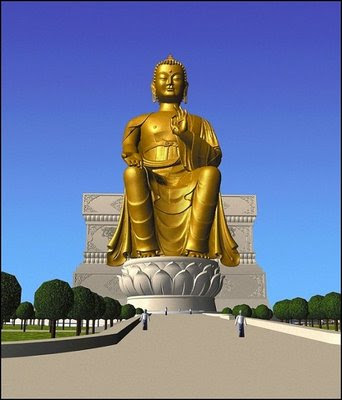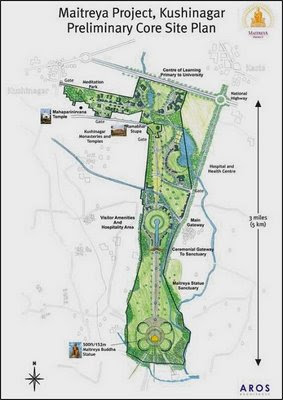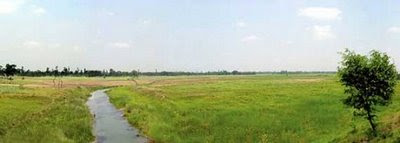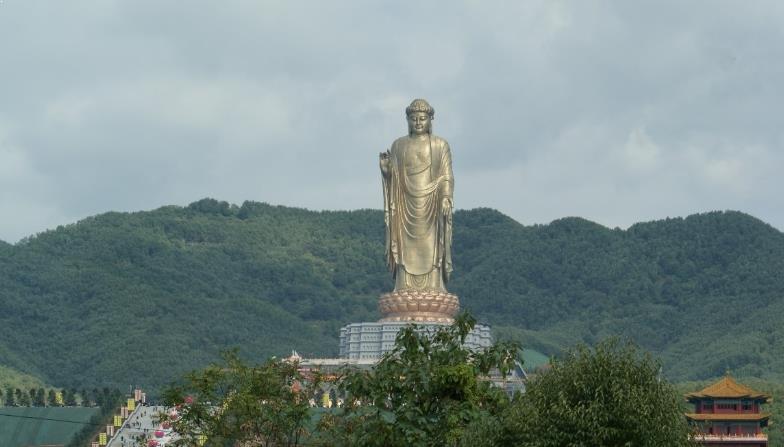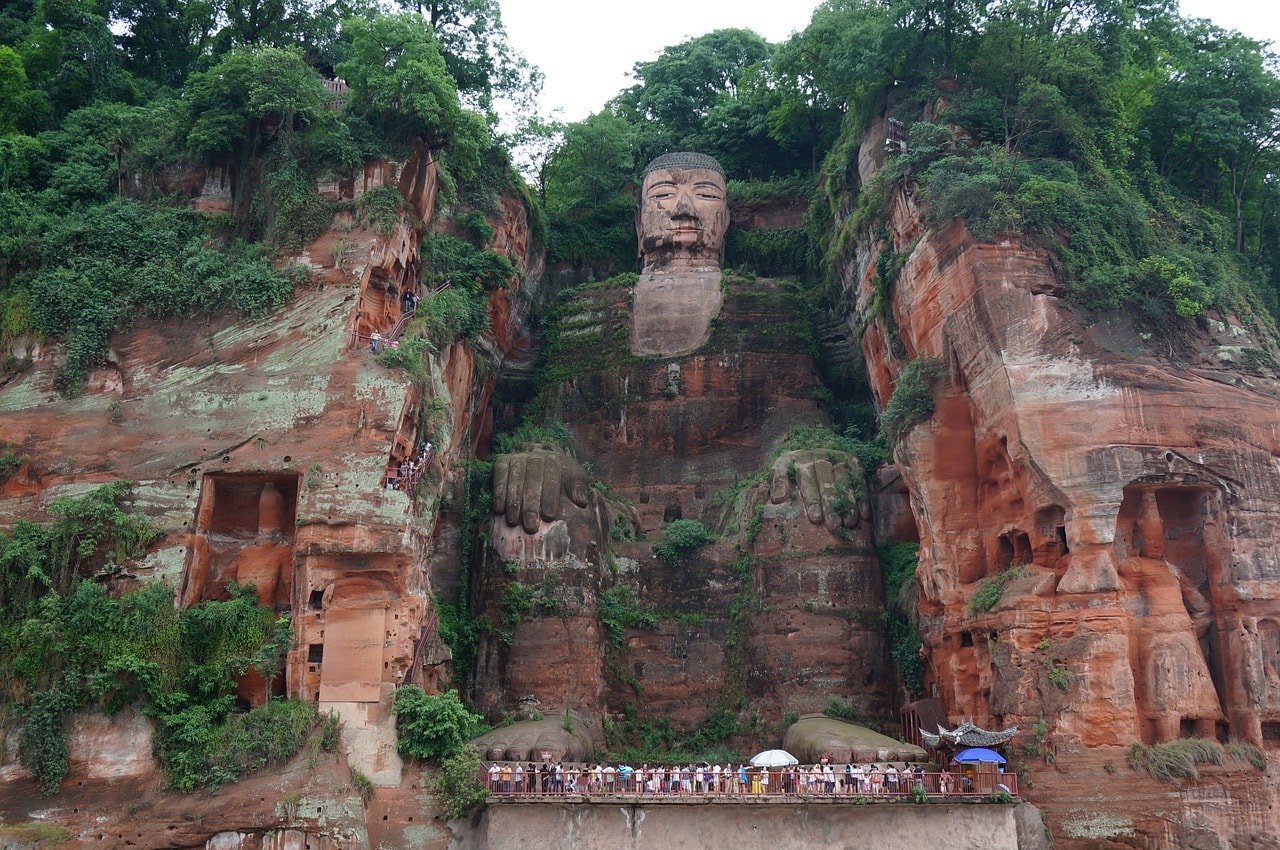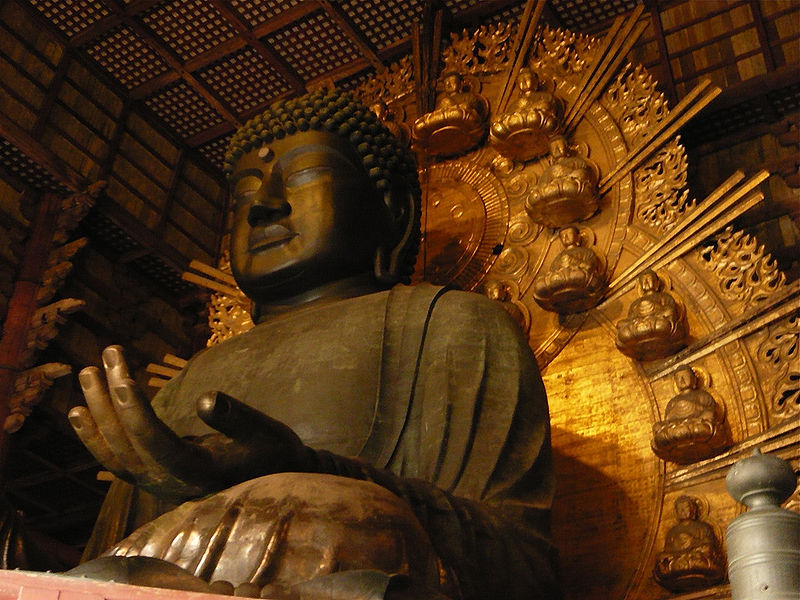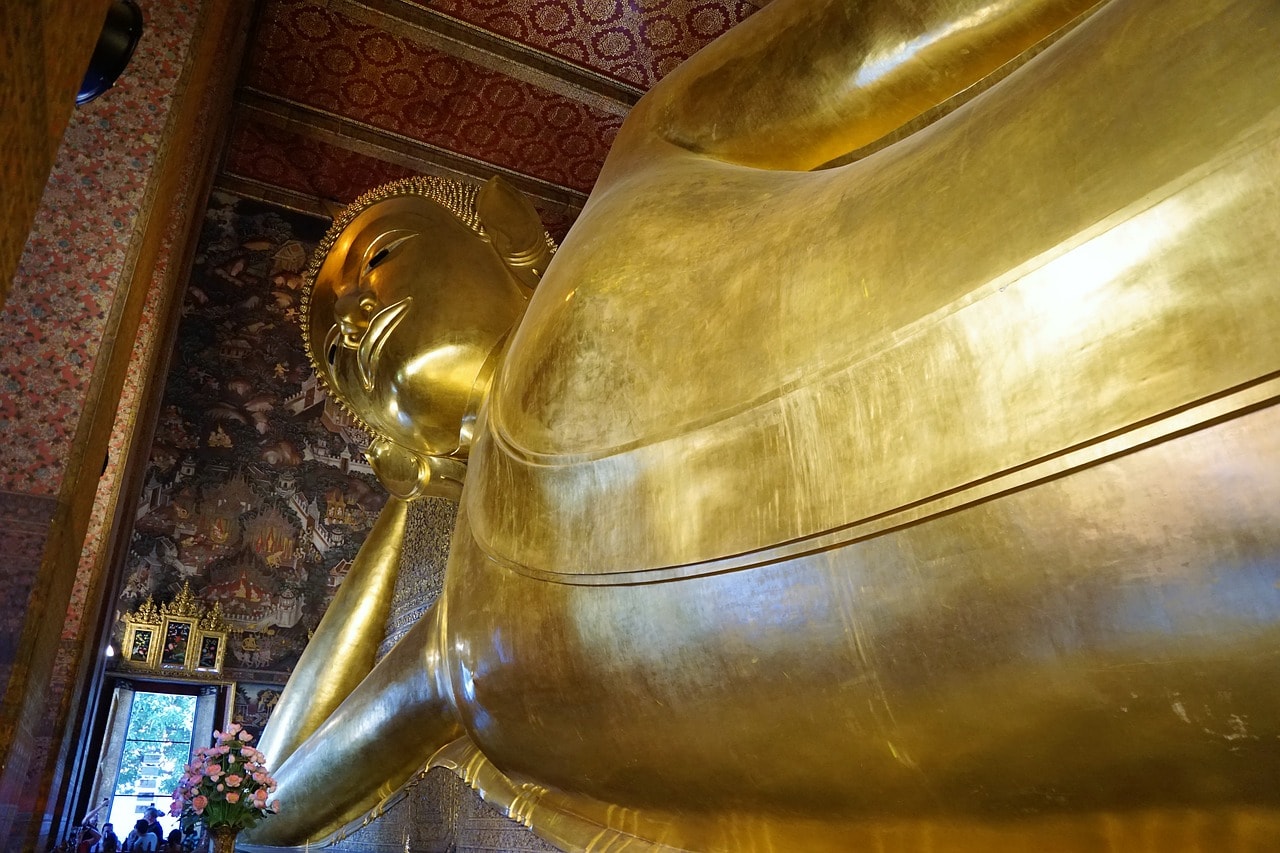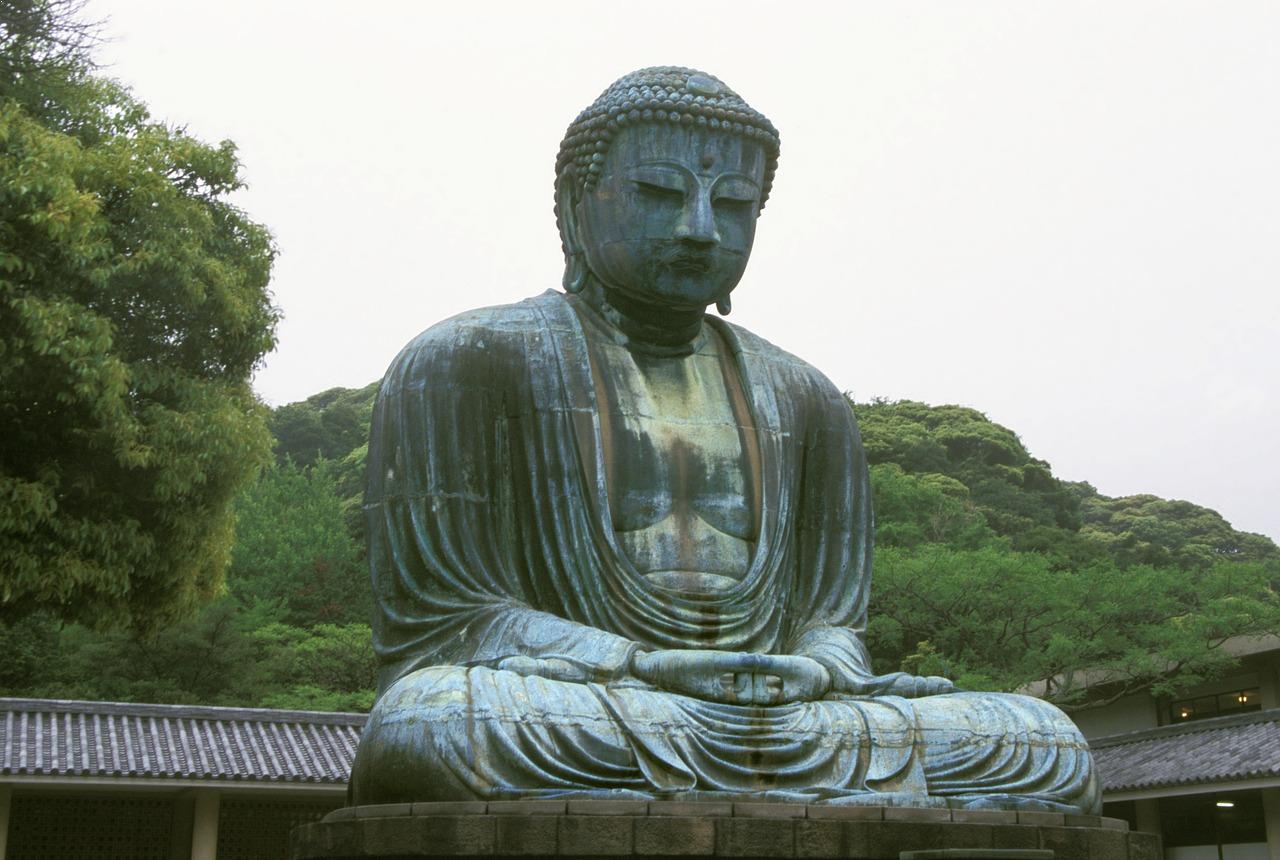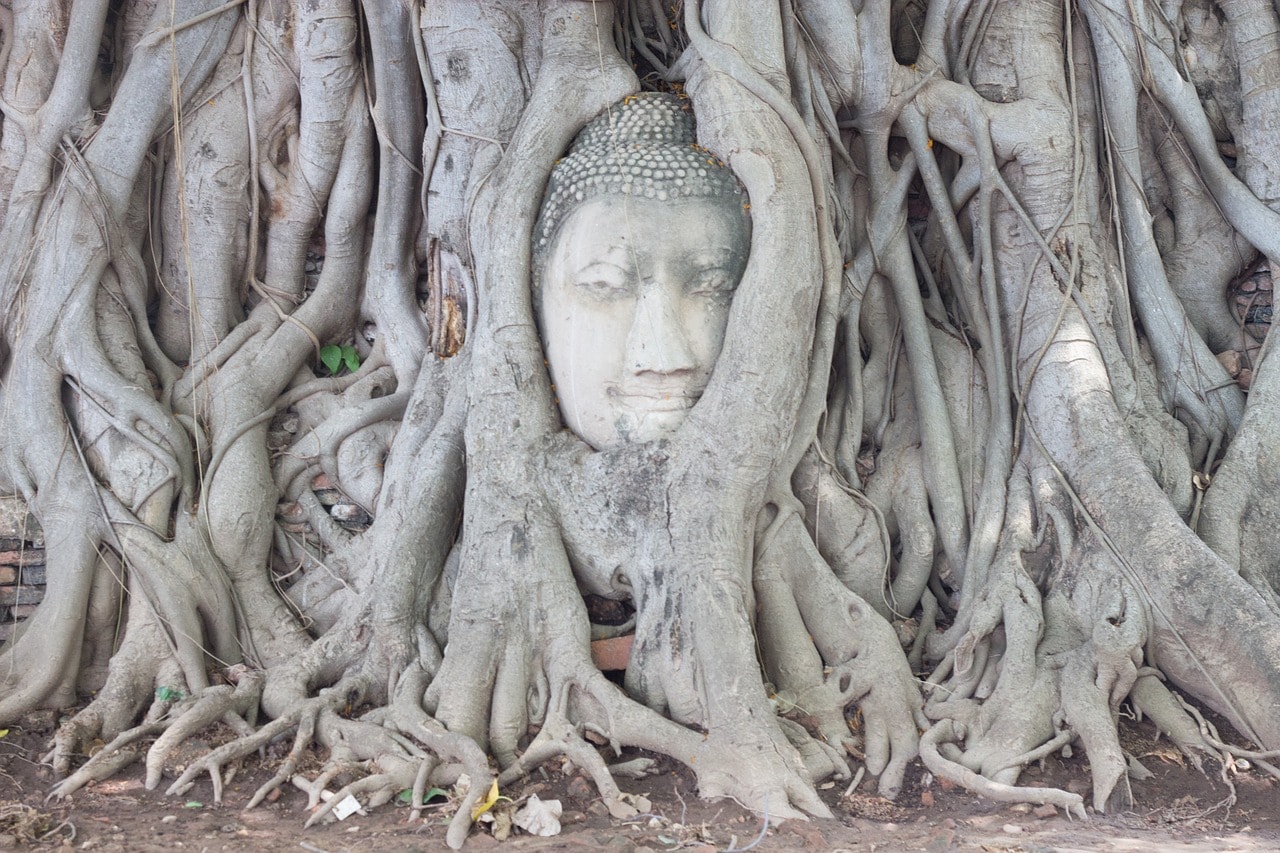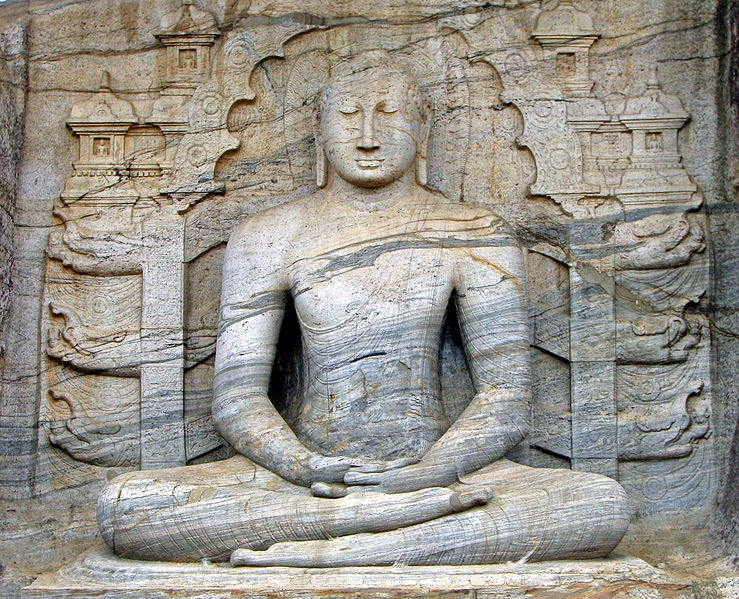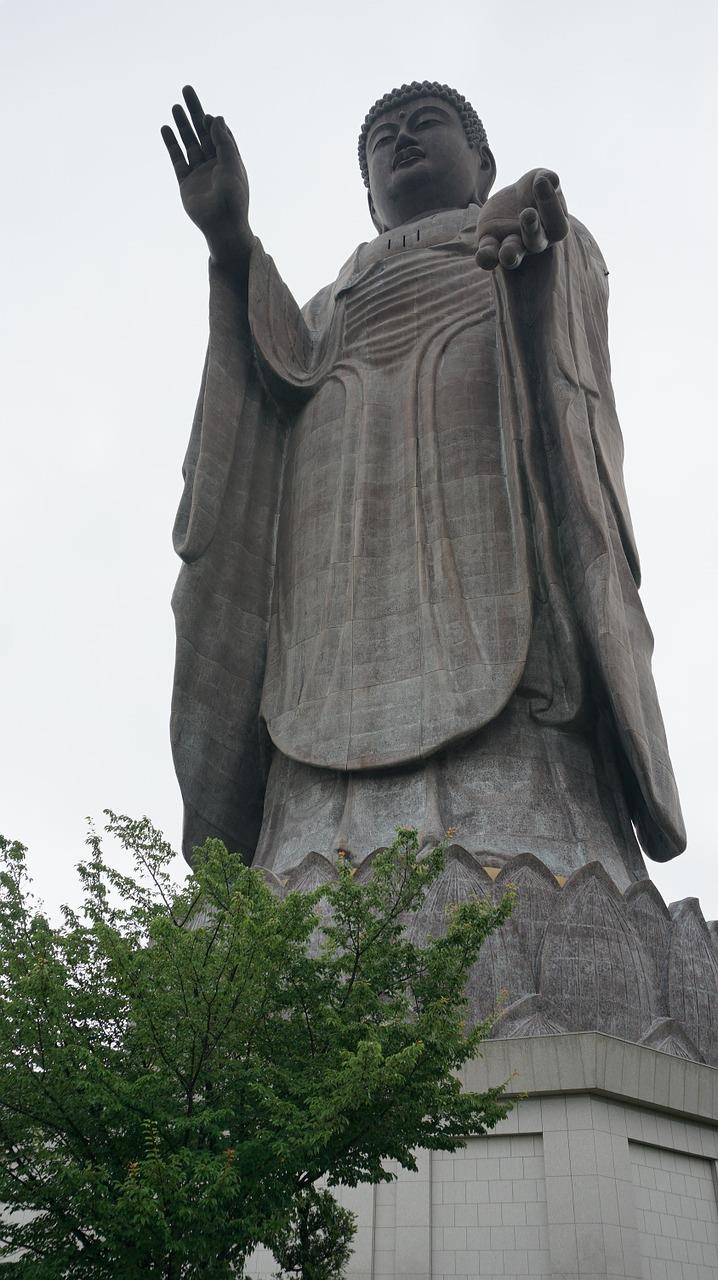LESSON 3400 Fri 31 Jul 2020
For
The Welfare, Happiness, Peace of All Sentient and Non-Sentient Beings and for them to Attain Eternal Peace as Final Goal.
KUSHINARA NIBBANA BHUMI PAGODA
in 116 CLASSICAL LANGUAGES
Through
At
WHITE HOME
668, 5A main Road, 8th Cross, HAL III Stage,
Prabuddha Bharat Puniya Bhumi Bengaluru
Magadhi Karnataka State
PRABUDDHA BHARAT
on 04-8-2020
DO GOOD PURIFY MIND AND ENVIRONMENT Words of the Metteyya Awakened One with Awareness
Free Online step by step creation of Virtual tour in 3D Circle-Vision 360° for Kushinara Nibbana Bhumi Pagoda
Most Famous Buddha Statues In The World
A Travelogue Of My
Struggle - Ridden Life And Bahujan Movement
After going through
both the volumes of A Travelogue Of My Struggle - Ridden Life And Bahujan
Movement it is concluded that:
Bahanji Ms Mayawati, the Original Inhabitant of Jambudvipa, that is the
Great Prabuddha Bharath,
is
MUCH MORE than a
Chief Minister or would be Prime Minister
Has
EXALTED, BLESSED, NOBLE AND AN AWAKENED MIGHTY GREAT MIND
Engaged to
Organise, Educate and Concentrate one and all
For the
Welfare, Happiness and Peace within Ones self and Harmony with all
other sentient and non-sentient beings
In order to elevate them to become
Exalted, Blessed, Noble and an Awakened Mighty Great Mind
Whenever a true history is written in JAMBUDVIPA, THAT IS THE GREAT
PRABUDDHA BHARATH, 14TH OCTOBER would be observed as the real
Independence Day for the ORIGINAL INHABITANTS OF JAMBUDVIPA, THAT IS THE GREAT
PRABUDDHA BHARATH for it was on that day Baba sahib Dr. Ambedkar, seven before
attaining TheUltimate Bliss, with lakhs of his followers took Diksha and
returned back to the right path shown by EXALTED, BLESSED, NOBLE AND AN
AWAKENED MIGHTY GREAT MIND
Sharp Reaction To The
Desecration Of The EXALTED, BLESSED, NOBLE AND AN AWAKENED MIGHTY GREAT MIND’s
Statue
EXALTED, BLESSED, NOBLE AND AN AWAKENED MIGHTY GREAT MIND
Was a super sentient
being of the universe, who gave the message of humanism, compassion. Kindness,
truth, non-violence peace and fraternity to the mankind. Bahanji Ms Mayawati,
the Original Inhabitant of Jambudvipa, that is the Great Prabuddha Bharath
sharply opposed the demolition of two massive statues of such a super sentient
being, which were world heritage, as also desecration of other memorabilia of
His in the Bamian province of Afghanistan under a proclamation of the violent
and fundamentalist Taliban Government.
As the national
Vice-President of BSP, former Chief Minister of Uttar Pradesh and an MP, she
convened après conference at her Delhi residence on March
3, 2001 and said that mere condemnation of this heinous act by the Central
Government will not do. The Government should treat this issue seriously and arrive at a firm decision to
take it up at the international level.
Addressing media persons, she said Lord EXALTED, BLESSED, NOBLE AND AN
AWAKENED MIGHTY GREAT MIND is our ideal, who gave the message of humanism to
the world. His is a religion in which all are equal.
That is why our ideal and the messiah of ORIGINAL INHABITANTS OF
JAMBUDVIPA, THAT IS THE GREAT PRABUDDHA BHARATH, Baba Saheb Dr. Ambedkar after
a study of all religions arrived at the conclusion that his downtrodden society
could get a status of religious equality only within the right path shown by
the EXALTED, BLESSED, NOBLE AND AN AWAKENED MIGHTY GREAT MIND’s religion. That
is why at Nagpur in Maharashtra, on October 14, 1956 took Diksha and returned
back to the original path shown by the EXALTED, BLESSED, NOBLE AND AN AWAKENED
MIGHTY GREAT MIND.Several lakhs of ORIGINAL INHABITANTS OF JAMBUDVIPA, THAT IS
THE GREAT PRABUDDHA BHARATH followed his example and along with him they also
got initiated, which is a continuous process.
It is not only Baba Saheb
Ambedkar, but many countries in the world which believe in the right path shown
by the EXALTED, BLESSED, NOBLE AND AN AWAKENED MIGHTY GREAT MIND practice that
path. Statues of a sentient being like Lord EXALTED, BLESSED, NOBLE AND AN
AWAKENED MIGHTY GREAT MIND are being demolished on a large scale by the violent
regime of Taliban and BSP condemned it.
On March 2, the Central Government got a motion of condemnation passed
in Parliament, but it was her submission to the Central Government that the
tallest statues of EXALTED, BLESSED, NOBLE AND AN AWAKENED MIGHTY GREAT MIND in
Bamiyan are being demolished on a big scale. Merely a statement by the Government
about it will not serve any purpose.It is the responsibility of the Government
to take the initiative of raising the issue at the International level and
seeking a diplomatic solution to it.. Merely, a statement that it is being
condemned at International level and India also condemns is altogether
inadequate. Therefore, it is our submission that this alone will not serve any
purpose. It is the responsibility of the Central Government to take the
initiative for raising the issue at the international level and make efforts to
stop the Taliban immediately from carrying out its misdeed.
However, she believed that the people with a distructive bent of mind
will never like the EXALTED, BLESSED, NOBLE AND AN AWAKENED MIGHTY GREAT MIND
because they have a separate and uncivilised culture. Buddhists are ORIGINAL INHABITANTS OF JAMBUDVIPA, THAT IS
THE GREAT PRABUDDHA BHARATH and its culture. Whether it is selfe-styled Chief
of Taliban, Mulla Mohammed Omar, Chengiz Khan of Mangolia, former Prime Minsiter,
Indira Gandhi, the Prime Minister Mr.
Vajpayee and his associates, RSS, Bajrang Dal or Vidhva Hindu Parishat, they
all are the same category.
THIS IS BECAUSE THE WAY THE SELF-STYLED Chief of the Taliban, Mul;la
Omar is possessed with a madness to demolish the 2000 years old world heritage,
EXALTED, BLESSED, NOBLE AND AN AWAKENED MIGHTY GREAT MIND statues, Chengiz Khan
of Mangolia was also possessed with a similar madness. But it is said that
these statues of EXALTED, BLESSED, NOBLE AND AN AWAKENED MIGHTY GREAT MIND were
so massive that like the Taliban the Mangol army used mortar and cannons but
could not destroy these statues. They could only chip away some bits under the
feet of the statues, which are 175 feet high and massive and have been carved out
of a massive hill. They are unique. Today, if the Taliban government succeeds in damaging of
the statues more than the Mongolian army did, they are not going to be covered
with any glory. The whole world is condemning those holding responsible
position in Taliban Government. They
should know that this brutal act of theirs is nothing better than banging one’s
against stone, but what can they do? Those who cannot think of anything good
start banging their gheads against stone. These EXALTED, BLESSED, NOBLE AND AN
AWAKENED MIGHTY GREAT MIND ststues have done no harm to them. But can you
destroy the ideas of the EXALTED, BLESSED, NOBLE AND AN AWAKENED MIGHTY GREAT
MIND by breaking and desecrating these statues ? Never.
Similarly, the former Prime
Ministers Indira Gandhi and Atal Bihari Vajpayee chose the day of EXALTED,
BLESSED, NOBLE AND AN AWAKENED MIGHTY GREAT MIND’s Jayanti (birth anniversary –
May 18, 1974 and May 11, 1998) for carrying out atomic explosions and the code
word “Buddha Smiles” was used to convey the success of these explosions.
When the entire world knows that the EXALTED, BLESSED, NOBLE AND AN
AWAKENED MIGHTY GREAT MIND gave the message of humanism, compassion, kindness,
love, truth non-violence, peace and fraternity, how can he smile at atomic
explosion ?
This can be the smile of only those with violent bent of mind, who
always entertain violent, destructive and inhuman thoughts. If such a work was
carried out by taking the name of the EXALTED, BLESSED, NOBLE AND AN AWAKENED
MIGHTY GREAT MIND, was it not akin to insulting Mahatma EXALTED, BLESSED, NOBLE AND AN AWAKENED
MIGHTY GREAT MIND in the same way as the Taliban government is doing by
demolishing His statues ?
History is witness to the fact that the Invader rulers who came from
central Asia were not any less than the
Taliban chiefs and Chengiz of Mangolia. Mrs. Indira Gandhi during her regime in
1984 issued the order for firing rockets and cannon balls at the Golden Temple
of the Sikhs and Hindu Chiefs of the then Prime Minister Vajpayee’s associate
organizations, RSS, Vishva Hindu Parishad and Bajrang Dal demolished the Babri
Mosque of the Muslims, which was condemned all over the world and was a blot on
Indian democracy.
But it needs to be thought what message these people with violent bent
of mind want to give to the world with their inhuman acts?
And after succeeding in their object of committing such
barbaric acts how can they spend their life in peace?
It is, therefore, necessary to tell these people with barbarian
mentality that the awakened people of today will never forgive the people with
such a violent frame of mind. History is witness to the fact that the people
with such a mentality have always met with utter ruination. Today also they are
bound to be ruined.
Of all the other religions in the world, the RIGHT PATH SHOWN BY
EXALTED, BLESSED, NOBLE AND AN AWAKENED MIGHTY GREAT MIND is the most renowned,
old and first PATH devoted to the welfare for all sentient and non-sentient
beings. Even now there are many countries in the world following the RIGHT PATH
SHOWN BY EXALTED, BLESSED, NOBLE AND AN AWAKENED MIGHTY GREAT MIND. The Taliban
have tried to disfigure and demolish the statues of the EXALTED, BLESSED, NOBLE
AND AN AWAKENED MIGHTY GREAT MIND, which are massive rock structures, but the
RIGHT PATH SHOWN BY EXALTED, BLESSED, NOBLE AND AN AWAKENED MIGHTY GREAT MIND
is living and will always live. Destructive tendencies can never harm EXALTED,
BLESSED, NOBLE AND AN AWAKENED MIGHTY GREAT MIND but what a sorry fate befell
the Taliban government is known to all of us.
World’s Tallest Buddha Statue & An Academic Upliftment of Buddhists and Poor in India by Mayawatiji
https://earthnworld.com/buddha-statues/
A Travelogue Of My
Struggle - Ridden Life And Bahujan Movement
After going through
both the volumes of A Travelogue Of My Struggle - Ridden Life And Bahujan
Movement it is concluded that:
Bahanji Ms Mayawati, the Original Inhabitant of Jambudvipa, that is the
Great Prabuddha Bharath,
is
MUCH MORE than a
Chief Minister or would be Prime Minister
Has
EXALTED, BLESSED, NOBLE AND AN AWAKENED MIGHTY GREAT MIND
Engaged to
Organise, Educate and Concentrate one and all
For the
Welfare, Happiness and Peace within Ones self and Harmony with all
other sentient and non-sentient beings
In order to elevate them to become
Exalted, Blessed, Noble and an Awakened Mighty Great Mind
Whenever a true history is written in JAMBUDVIPA, THAT IS THE GREAT
PRABUDDHA BHARATH, 14TH OCTOBER would be observed as the real
Independence Day for the ORIGINAL INHABITANTS OF JAMBUDVIPA, THAT IS THE GREAT
PRABUDDHA BHARATH for it was on that day Baba sahib Dr. Ambedkar, seven before
attaining TheUltimate Bliss, with lakhs of his followers took Diksha and
returned back to the right path shown by EXALTED, BLESSED, NOBLE AND AN
AWAKENED MIGHTY GREAT MIND
Sharp Reaction To The
Desecration Of The EXALTED, BLESSED, NOBLE AND AN AWAKENED MIGHTY GREAT MIND’s
Statue
EXALTED, BLESSED, NOBLE AND AN AWAKENED MIGHTY GREAT MIND
Was a super sentient
being of the universe, who gave the message of humanism, compassion. Kindness,
truth, non-violence peace and fraternity to the mankind. Bahanji Ms Mayawati,
the Original Inhabitant of Jambudvipa, that is the Great Prabuddha Bharath
sharply opposed the demolition of two massive statues of such a super sentient
being, which were world heritage, as also desecration of other memorabilia of
His in the Bamian province of Afghanistan under a proclamation of the violent
and fundamentalist Taliban Government.
As the national
Vice-President of BSP, former Chief Minister of Uttar Pradesh and an MP, she
convened après conference at her Delhi residence on March
3, 2001 and said that mere condemnation of this heinous act by the Central
Government will not do. The Government should treat this issue seriously and arrive at a firm decision to
take it up at the international level.
Addressing media persons, she said Lord EXALTED, BLESSED, NOBLE AND AN
AWAKENED MIGHTY GREAT MIND is our ideal, who gave the message of humanism to
the world. His is a religion in which all are equal.
That is why our ideal and the messiah of ORIGINAL INHABITANTS OF
JAMBUDVIPA, THAT IS THE GREAT PRABUDDHA BHARATH, Baba Saheb Dr. Ambedkar after
a study of all religions arrived at the conclusion that his downtrodden society
could get a status of religious equality only within the right path shown by
the EXALTED, BLESSED, NOBLE AND AN AWAKENED MIGHTY GREAT MIND’s religion. That
is why at Nagpur in Maharashtra, on October 14, 1956 took Diksha and returned
back to the original path shown by the EXALTED, BLESSED, NOBLE AND AN AWAKENED
MIGHTY GREAT MIND.Several lakhs of ORIGINAL INHABITANTS OF JAMBUDVIPA, THAT IS
THE GREAT PRABUDDHA BHARATH followed his example and along with him they also
got initiated, which is a continuous process.
It is not only Baba Saheb
Ambedkar, but many countries in the world which believe in the right path shown
by the EXALTED, BLESSED, NOBLE AND AN AWAKENED MIGHTY GREAT MIND practice that
path. Statues of a sentient being like Lord EXALTED, BLESSED, NOBLE AND AN
AWAKENED MIGHTY GREAT MIND are being demolished on a large scale by the violent
regime of Taliban and BSP condemned it.
On March 2, the Central Government got a motion of condemnation passed
in Parliament, but it was her submission to the Central Government that the
tallest statues of EXALTED, BLESSED, NOBLE AND AN AWAKENED MIGHTY GREAT MIND in
Bamiyan are being demolished on a big scale. Merely a statement by the Government
about it will not serve any purpose.It is the responsibility of the Government
to take the initiative of raising the issue at the International level and
seeking a diplomatic solution to it.. Merely, a statement that it is being
condemned at International level and India also condemns is altogether
inadequate. Therefore, it is our submission that this alone will not serve any
purpose. It is the responsibility of the Central Government to take the
initiative for raising the issue at the international level and make efforts to
stop the Taliban immediately from carrying out its misdeed.
However, she believed that the people with a distructive bent of mind
will never like the EXALTED, BLESSED, NOBLE AND AN AWAKENED MIGHTY GREAT MIND
because they have a separate and uncivilised culture. Buddhists are ORIGINAL INHABITANTS OF JAMBUDVIPA, THAT IS
THE GREAT PRABUDDHA BHARATH and its culture. Whether it is selfe-styled Chief
of Taliban, Mulla Mohammed Omar, Chengiz Khan of Mangolia, former Prime Minsiter,
Indira Gandhi, the Prime Minister Mr.
Vajpayee and his associates, RSS, Bajrang Dal or Vidhva Hindu Parishat, they
all are the same category.
THIS IS BECAUSE THE WAY THE SELF-STYLED Chief of the Taliban, Mul;la
Omar is possessed with a madness to demolish the 2000 years old world heritage,
EXALTED, BLESSED, NOBLE AND AN AWAKENED MIGHTY GREAT MIND statues, Chengiz Khan
of Mangolia was also possessed with a similar madness. But it is said that
these statues of EXALTED, BLESSED, NOBLE AND AN AWAKENED MIGHTY GREAT MIND were
so massive that like the Taliban the Mangol army used mortar and cannons but
could not destroy these statues. They could only chip away some bits under the
feet of the statues, which are 175 feet high and massive and have been carved out
of a massive hill. They are unique. Today, if the Taliban government succeeds in damaging of
the statues more than the Mongolian army did, they are not going to be covered
with any glory. The whole world is condemning those holding responsible
position in Taliban Government. They
should know that this brutal act of theirs is nothing better than banging one’s
against stone, but what can they do? Those who cannot think of anything good
start banging their gheads against stone. These EXALTED, BLESSED, NOBLE AND AN
AWAKENED MIGHTY GREAT MIND ststues have done no harm to them. But can you
destroy the ideas of the EXALTED, BLESSED, NOBLE AND AN AWAKENED MIGHTY GREAT
MIND by breaking and desecrating these statues ? Never.
Similarly, the former Prime
Ministers Indira Gandhi and Atal Bihari Vajpayee chose the day of EXALTED,
BLESSED, NOBLE AND AN AWAKENED MIGHTY GREAT MIND’s Jayanti (birth anniversary –
May 18, 1974 and May 11, 1998) for carrying out atomic explosions and the code
word “Buddha Smiles” was used to convey the success of these explosions.
When the entire world knows that the EXALTED, BLESSED, NOBLE AND AN
AWAKENED MIGHTY GREAT MIND gave the message of humanism, compassion, kindness,
love, truth non-violence, peace and fraternity, how can he smile at atomic
explosion ?
This can be the smile of only those with violent bent of mind, who
always entertain violent, destructive and inhuman thoughts. If such a work was
carried out by taking the name of the EXALTED, BLESSED, NOBLE AND AN AWAKENED
MIGHTY GREAT MIND, was it not akin to insulting Mahatma EXALTED, BLESSED, NOBLE AND AN AWAKENED
MIGHTY GREAT MIND in the same way as the Taliban government is doing by
demolishing His statues ?
History is witness to the fact that the Invader rulers who came from
central Asia were not any less than the
Taliban chiefs and Chengiz of Mangolia. Mrs. Indira Gandhi during her regime in
1984 issued the order for firing rockets and cannon balls at the Golden Temple
of the Sikhs and Hindu Chiefs of the then Prime Minister Vajpayee’s associate
organizations, RSS, Vishva Hindu Parishad and Bajrang Dal demolished the Babri
Mosque of the Muslims, which was condemned all over the world and was a blot on
Indian democracy.
But it needs to be thought what message these people with violent bent
of mind want to give to the world with their inhuman acts?
And after succeeding in their object of committing such
barbaric acts how can they spend their life in peace?
It is, therefore, necessary to tell these people with barbarian
mentality that the awakened people of today will never forgive the people with
such a violent frame of mind. History is witness to the fact that the people
with such a mentality have always met with utter ruination. Today also they are
bound to be ruined.
Of all the other religions in the world, the RIGHT PATH SHOWN BY
EXALTED, BLESSED, NOBLE AND AN AWAKENED MIGHTY GREAT MIND is the most renowned,
old and first PATH devoted to the welfare for all sentient and non-sentient
beings. Even now there are many countries in the world following the RIGHT PATH
SHOWN BY EXALTED, BLESSED, NOBLE AND AN AWAKENED MIGHTY GREAT MIND. The Taliban
have tried to disfigure and demolish the statues of the EXALTED, BLESSED, NOBLE
AND AN AWAKENED MIGHTY GREAT MIND, which are massive rock structures, but the
RIGHT PATH SHOWN BY EXALTED, BLESSED, NOBLE AND AN AWAKENED MIGHTY GREAT MIND
is living and will always live. Destructive tendencies can never harm EXALTED,
BLESSED, NOBLE AND AN AWAKENED MIGHTY GREAT MIND but what a sorry fate befell
the Taliban government is known to all of us.
World’s Tallest Buddha Statue & An Academic Upliftment of Buddhists and Poor in India by Mayawatiji
now the Maitreya Buddha Statue is to be another gem added to this crow.
The statue is averitable temple-skyscraper that will contain 17
individual shrine rooms. The highest room at 140 meters high — the
equviliant height ofthe 40th storey of a standard building. This statue
and complex will be a fusion of Indian and Tibetan architectural styles
that will adhere to ancient Vaastu Shastra design code and will also
hold the world’s largest collection of Lord Buddha’s relics.
cutaway view of the 152 meter Maitreya statue and throne building
showing the spaces and levels within. Note that the throne itself will
be a 17 storey fully functional temple, with 15 additional shrine rooms
in the the body of the Maitreya ( Metteyya Awakened One with Awareness)
statue.
Project engineers on-siteMayawatiji govt in UP is all set to build the
world’s Tallest Buddha statue, this is an uplifting project in various
means. First it would help heal the sabotaged
buddhists/SC/STs/Ambedkarites, second, it would bring tourism industry
at a big level to UP through which the state can benefit in economic and
social changes, it would help peace and better living of people in this
area by following Buddha’s path……….it is a great idea and project. If
done, this would just uplift the BSP itself and it’s supremo to further
higher level in the world of Buddhism and good humans.which is not just a
statue but an academy to uplift the poor, one and all.
correspondents in Uttar Pradesh, India, 03:33 PM IST Decks are being
cleared for the installation of the world’s tallest Buddha statue in
Kushinagar town of eastern Uttar Pradesh.Uttar Pradesh Chief Minister
Mayawati was understood to have directed officials to speed upthe
acquisition and transfer of 600 acres of land required for the Rs.10
billion project to be funded and undertaken by the global Maitryi group.
Proviuion of land is UP government’s share in the project.. The project
involves installation of a 152-metre-tall bronze statue of Lord Buddha
along with a giant meditation centre, an international university, a
state-of-art world-class hospital and a museum. The project also
envisages an entertainment complex in the neighbourhood that would
include an amusement park and a five-star hotel.UP Chief Secretary
Prashant Kumar Misra presided over a high level meeting of state
officials, in which representatives from Maitryi were present here
Monday. A presentation on the project was made. Significantly, the
project was initiated during the previous tenure of Chief Minister
Mayawati in 2003, after which it was put on the backburner during the
Singh Yadav regime. ‘Since then, it had been hanging fire, so we
decided to revive it after Maitryi officials approached us,’ Misra told
IANS. He said: ‘Of the 600 acres required for the project, we need to
acquire only about 300 acres while the rest is government land.‘The
government had already started the acquisition process. The whole
project would not involve any major displacement of people and not more
than 70-80 farmers would be involved,’ he said.‘We have worked out a
handsome rehabilitation package for the farmers who would get displaced
on account of the project.’
of these features will be set in beautifully landscaped parks with
meditation pavilions, beautiful water fountains and tranquil pools. All
of the buildings and outdoor features will contain an extensive
collection of inspiring sacred art.

^ Maitreya Project engineers on-site
Buddha statue, this is an uplifting project in various means. First it
would help heal the sabotaged buddhists/dalits/Ambedkarites, second, it
would bring tourism industry at a big level to UP through which the
state can benefit in economic and social changes, it would help peace
and better living of people in this area by following Buddha’s
path……….it is a great idea and project. If done, this would just
uplift the BSP itself and it’s supremo to further higher level in the
world of Buddhism and good humans.
which is not just a statue but an academy to uplift the poor, one and all.
From correspondents in Uttar Pradesh, India, 03:33 PM IST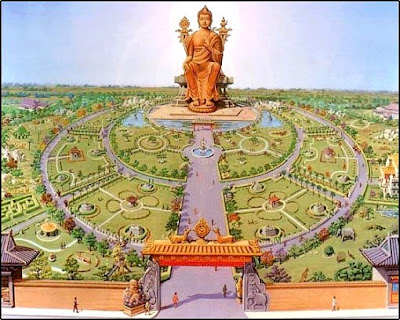
Decks are being cleared for the installation of the world’s tallest Buddha statue in Kushinagar town of eastern Uttar Pradesh.
Uttar Pradesh Chief Minister Mayawati was understood to have directed officials to speed 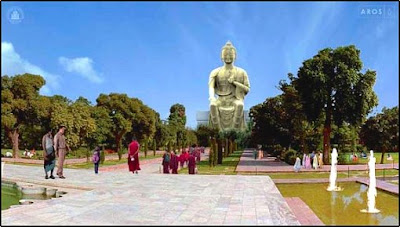 up
up
the acquisition and transfer of 600 acres of land required for the
Rs.10 billion project to be funded and undertaken by the global Maitryi
group. Proviuion of land is UP government’s share in the project.. The
project involves installation of a 152-metre-tall bronze statue of Lord
Buddha along with a giant meditation centre, an international
university, a state-of-art world-class hospital and a museum. The
project also envisages an entertainment complex in the neighbourhood
that would include an amusement park and a five-star hotel.
UP
Chief Secretary Prashant Kumar Misra presided over a high level meeting
of state officials, in which representatives from Maitryi were present
here Monday. A presentation on the project was made. Significantly, the
project was initiated during the previous tenure of Chief Minister
Mayawati in 2003, after which it was put on the backburner during the
Mulayam Singh Yadav regime. ‘Since then, it had been hanging fire, so
we decided to revive it after Maitryi officials approached us,’ Misra
told IANS. He said: ‘Of the 600 acres required for the project, we need
to acquire only about 300 acres while the rest is government land.
‘The
government had already started the acquisition process. The whole
project would not involve any major displacement of people and not more
than 70-80 farmers would be involved,’ he said.
‘We have worked out a handsome rehabilitation package for the farmers who would get displaced on account of the project.’
^ A View from the Maitreya Project Park
All of these features will be set in beautifully
landscaped parks with meditation pavilions, beautiful water fountains
and tranquil pools. All of the buildings and outdoor features will
contain an extensive collection of inspiring sacred art.
the Maitreya Buddha statue is a four-storey halo of buildings called
the “Living Wall.” This ring of buildings contains accomadation for the
complex’s monks and workers as well as rooms for functions ancillary to
the statue and throne building.
wall also serves two additional important functions. In light of
cross-border Islamist terrorist attacks against Indian holy sites in
Ayodhya, Akshardham and Jama Masjid, the Living Wall also is designed to
be a security cordon eqivalent to a modern castle wall, staffed with
security personnel and designed to withstand an attack from 200 heavily
armed raiders.
final major function it performs is that of the boundary for the
enclosed sanctuary area of landscaped gardens, pools and fountains for
meditation directly surrounding the Maitreya statue. The entry to the
enclosed sanctuary and the Maitreya statue will be serviced by a main
gate.
center of the Maitreya Project, of course, is the bronze plate statue
of the Maitreya Buddha itself. Rising 500ft/152m in height, the statue
will sit on a stone throne temple building located in an enclosed
sanctuary park.
the sanctuary, the gardens provide a place for relaxing, resting, and
meditating, with educational artwork depicting the Buddha’s life.
further inward, the is Maitreya Statue and Throne Temple, surrounded by
tranquil ponds and fountains that will cool the area in the intense
Indian summer.
building will contain two very large prayer halls, as well as
meditation and meeting rooms, a library and facilities to deal with the
anticipated annual influx of 2 million visitors.
entrance to the throne building with the Maitreya Buddha statue resting
upon the lotus on top Pilgrims will enter the throne temple through the
giant lotus that supports the Maitreya Buddha statue’s feet. The throne
temple contains several entrance rooms that contain works of art on the
Buddha’s life and teachings.
inward is the cavernous main auditorium of the Maitreya Temple
containing the Sanctum Sanctorum which in Indian architectural tradition
is the innermost most sacred room where the actual shrine is held. This
Sanctum Sanctorum is unique in that within it contains two large
auditorium temples.
first temple in the Sanctum Sanctorum is the Temple of the Maitreya
Buddha, containing a huge, 12 meter tall statue of the Buddha.
wall containing 200,000 images of the Buddhas rises up to the throne
ceiling over 50 metres above, behind both auditorium temples.
centerpiece shrine of the Maitreya Temple is the 12 meter tall Maitreya
Buddha. Stairs and elevators lead to viewing platforms around the
Maitreya Temple, allowing views of the entire room
next biggest shrine in the Sanctum Sanctorum is the Temple of the
Shakyamuni Buddha which contains a 10 meter statue of the Shakyamuni
(Historical) Buddha.
a higher level yet again, the Shakyamuni Temple will house a 10 metre
(33 ft.) statue of the historical Buddha. The glass rear wall will
reveal the wall of 200,000 Buddhas within the Maitreya Temple.
Indian architecture, the Sanctum Sanctorum is encircled by a pathway
that allows devotees to do Pradakshina (circumambulation) of the shrine.
The Maitreya Temple, following this tradition, also has this feature.
main throne building and Pradakshina path where visitors may
circumambulate Sanctum Sanctorum of the Maitreya Temple, which can be
seen through the doorways on the right
this area, elevators and staircases will carry visitors to the various
other rooms in the 17 storey base, including prayer halls, meditation
halls and libraries. Eventually conveying devotees to a large rooftop
garden terrace upon which the Maitreya Buddha statue actually rests.
rising into the upper legs of the main statue, is the Merit Field Hall
with a 10 meter, 3-dimensional depiction of over 390 Buddhas and
Buddhist masters at it’s center. Surrounding this will be 12 individual
shrine rooms devoted to particular deities in the Hindu-Buddhist
pantheon.
the garden terrace, another bank of elevators will whisk pilgrims to
the higher shrine rooms contained in the statue’s torso and head.
have a total height of 152 meters, with the highest shrine room in the
statue’s head, at over 140 meters up. This is roughly equivalent in
height to a 40-storey skyscraper.
statue is itself an engineering marvel. Rather than simply be designed
in its massive size, the statue of the Maitreya Buddha was actually
reversed-designed from a carved statue only a meter and half in height
and the structure’s engineering extrapolated into its current form.
original statue from which the Maitreya Buddha statue tower is
extrapolated from was hand carved, and is in the Indian Gupta style.
the statue is designed to stand for at least 1,000 years, supporting
the Project’s spiritual and social work for at least a millennium. Due
to the statue’s millenia-passing lifespan, the huge structure is
designed to withstand high winds, extreme temperature changes, seasonal
rains, possible earthquakes and floods and environmental pollution.
research has gone into developing “Nikalium”, the special
nickel-aluminum bronze alloy to be used for the outer ’skin’ of the
statue designed to withstand the most challenging conditions that could
conceivably arise.
the bronze ’skin’ will expand and contract dramatically due to daily
temperature changes, the statue will require special expansion joints
that were designed to be not only invisible to the observer, but also in
such a way as to protect the internal supports of the statue from water
leakage, erosion and corrosion. The material and structural components
of the statue are meant to be able to withstand potential unforseen
disasters like earthquakes and monsoon flooding.
Maitreya Project recently passed its first major milestone this month,
when, in compliance with the Indian Land Acquistion Act, the State
Government of Uttar Pradesh has completed the necessary legal
requirements for the acquisition of the 750 acre land site to be made
available to the Project.
there are still permissions and clearances to be obtained, it has now
officially given the green light and the full support of the government.
is expected that the Project will formally break ground either later
this year or early 2008, with an expected construction time of five
years. The project will employ more than a thousand skilled and
semi-skilled workers in the construction phase.
for the length of the post, but I wanted this veritable essay to be a
comprehensive introduction to what Maitreya Project organizers aim to
literally be the 8th Wonder of the World, and an everlasting symbol of
Religious Syncretism, Tolerance, Compassion and most of all, Love.
this sound good to you? Here’s a story about something similar in
Australia: Nowra to get its own Kung Fu temple: Australia ABN
Decks are being cleared for the installation of the world’s tallest
Buddha statue in Kushinagar town of eastern Uttar Pradesh.
Pradesh Chief Minister Mayawati was understood to have directed
officials to speed up the acquisition and transfer of 600 acres of land
required for the Rs 10 billion project to be funded and undertaken by
the global Maitryi Group. Provision of land is UP government’s share in
the project.
project involves installation of a 152-metre-tall bronze statue of Lord
Buddha along with a giant meditation centre, an international
university, a state-of-art world-class hospital and a museum. The
project also envisages an entertainment complex in the neighbourhood
that would include an amusement park and a five-star hotel. Nowra to get
its own Kung Fu temple: Australia
will be a three-tier temple complex, with two pagodas, 500-room hotel, a
500-place kung fu academy. There’ll be some esidential subdivision, a
27-hole golf course, herbal medicine, herbal gardens, acupuncture,
special massage, and that’s about it.
PENG: The Shaolin of course is very well known in China itself, so he
like to take this opportunity to try to introduce the Shaolin legacy,
the heritage to the rest of the world, through another outlet.
TAYLOR: The NSW Government is still to give final approval to the
project. But speaking in Beijing yesterday, Mayor Gre Watson wasn’t
expecting a fight.
WATSON: What happened was, I heard via a Member of Parliament, that the
Abbott was looking for a potential location to establish the second
Shaolin temple in the world, somewhere in
themselves more relevant to the modern world, and really they’re not
exclusive, they’re not just men in the caves, you know.
Pradesh Chief Minister Mayawati was understood to have directed
officials to speed up the acquisition and transfer of 600 acres of land
required for the Rs.10 billion project to be funded and undertaken by
the global Maitryi group.
project involves installation of a 152-metre-tall bronze statue of Lord
Buddha along with a giant meditation centre, an international
university, a state-of-art world-class hospital and a museum. The
project also envisages an entertainment complex in the neighbourhood
that would include an amusement park and a five-star hotel.
Chief Secretary Prashant Kumar Misra presided over a high level meeting
of state officials, in which representatives from Maitryi were present
here Monday. A presentation on the project was made.
the project was initiated during the previous tenure of Chief Minister
Mayawati in 2003, after which it was put on the backburner during the
Mulayam Singh Yadav regime.
whole project would not involve any major displacement of people and
not more than 70-80 farmers would be involved,” he said.
Minister Mayawati has asked officials to speed up acquisition
andtransfer of 600 acres of land required for the Rs10bn project to be
funded and undertaken by the global Maitryi group.
state government will give the land for the project which involves
installation of a 152m tall bronze statue of Lord Buddha along with a
giant meditation centre, an international university, a state-of-art
hospital and a museum.
project also envisages an entertainment complex in the neighbourhood
that would include an amusement park and a five-star hotel.
over a high level meeting of state officials, in which representatives
from Maitryi were present here on Monday. A presentation on the project
was made.
the 600 acres required for the project, we need to acquire only about
From correspondents in Uttar Pradesh, India, 03:33 PM IST
Pradesh Chief Minister Mayawati was understood to have directed
officials to speed up the acquisition and transfer of 600 acres of land
required for the Rs.10 billion project to be funded and undertaken by
the global Maitryi group.
project involves installation of a 152-metre-tall bronze statue of Lord
Buddha along with a giant meditation centre, an international
university, a state-of-art world-class hospital and a museum. The
project also envisages an entertainment complex in the neighbourhood
that would include an amusement park and a five-star hotel.
Chief Secretary Prashant Kumar Misra presided over a high level meeting
of state officials, in which representatives from Maitryi were present
here Monday. A presentation on the project was made.
the project was initiated during the previous tenure of Chief Minister
Mayawati in 2003, after which it was put on the backburner during the
Mulayam Singh Yadav regime.
whole project would not involve any major displacement of people and
not more than 70-80 farmers would be involved,’ he said.
Situated in Deoria district of eastern Uttar Pradesh, Kushinagara was a
small town in the days of the Buddha. But it became famous when the
Buddha died here, on his way from Rajgir to Sravasti. His last memorable
words were, “All composite things decay. Strive diligently!” This event
is known as the ‘Final Blowing-Out’ (Parinibbana) in Buddhist parlance.
then the place has become a celebrated pilgrim centre. It was the
capital of the kingdom of the Mallas, one of the 16 Janapadas (see
Sravasti).
Muktabandhana Stupa was built by the Mallas just after the Buddha’s
death. It is built over the sacred relics of the Buddha himself. The
Stupa is also known as Ramabhar Stupa and is 50 ft tall. It is believed
that the Stupa was built on the spot where the Buddha was cremated.
Stupa that was built in the days of Ashoka. It was renovated in 1927 by
the Burmese Buddhists. In front of the Stupa is the Mahaparinirvana
Temple in which is installed a colossal sandstone statue of the Buddha
in the reclining position. It was built by the Mathura school of art and
was brought to Kushinagar by a Buddhist monk named Haribala during the
reign of Kumaragupta (c. a.d.415-454).
in Kushinagar, it appears that time has come to a complete halt. This
sleepy town, with its serenity and unassuming beauty, absorbs visitors
into a contemplative mood. It is this place that the Buddha had chosen
to free himself from the cycles of death and life and, therefore, it
occupies a very special space in the heart of every Buddhist.
is situated in the north Indian state of Uttar Pradesh, 51 km off
Gorakhpur. The place, which is famous for the Mahaparinirvana (death) of
Lord Buddha, has been included in the famous Buddhist trail
encompassing Bihar, Uttar Pradesh, and Nepal.
is also known as Kasia or Kusinara. The founder of Buddhism, Lord
Buddha passed away at this place near the Hiranyavati River and was
cremated at the Ramabhar stupa. It was once a celebrated center of the
Malla kingdom. Many of its stupas and viharas date back to 230 BC-AD
413. when its prosperity
at the peak. The Mauryan emperor Ashoka added grandeur to this place by
getting the magnificent statue of Buddha carved on a single piece of
red sandstone. Fa Hien, Huen Tsang, and I-tsing, the three famous
Chinese scholar travelers to India, all visited Kushinagar.
and suffered much neglect. It was only in the last century that Lord
Alexander Cunningham excavated many important remnants of the main site
such as the Matha Kua and Ramabhar stupa. Today, people from all over
the world visit Kushinagar. Many national and international societies
and groups have established their centers here.
other places in the Gangetic plain, the climate of Kushinagar is hot
and humid in the summers (mid-April-mid-September) with Maximum
Temperature touching 40-45°C.
are mild and Minimum Temperature in December can go down to around 5°C.
Monsoon reaches this region in June and remains here till September
Mahaparinirvana temple (also known as the Nirvana temple) is the main
attraction of Kushinagar. It is a single room structure, which is raised
on a platform and is topped by a superstructure, which conforms to the
traditional Buddhist style of architecture. The Mahaparinirvana temple
houses the world famous 6m (19.68 ft) long statue of the reclining
Buddha.
archaeologists. The statue has been carved out from sandstone and
represents the dying Buddha. The figures carved on the four sides of the
small stone railing surrounding the statue, show them mourning the
death of Lord Buddha. According to an inscription found in Kushinagar,
the statue dates back to the 5th century AD.
is generally believed that Haribala, a Buddhist monk brought the statue
of the reclining Buddha to Kushinagar, from Mathura during 5th century,
during the period of the Gupta Empire.
Nibbana stupa is located behind the Mahaparinirvana temple. British
archaeologists discovered this brick structure during the excavation
carried out in 1876. Subsequent excavations carried out by the
Archaeological Survey of India (ASI) unearthed a copper vessel, which
contained the remains of Lord Buddha apart from precious stones, cowries
and a gold coin belonging to the
Mathakuar Shrine is an interesting place to visit in Kushinagar. It is
located near the Nirvana stupa. A statue of Buddha made out of black
stone was found here. The statue shows Buddha in the Bhumi Sparsha mudra
(pose in which Buddha is touching the earth with his fingers). It is
believed that Lord Buddha preached his last sermon here before his
death.
Ramabhar Stupa (also known as the Mukutabandhana stupa) is a 14.9 m (49
ft) tall brick stupa, which is located at a distance of 1 km from the
Mahaparinirvana temple. This stupa is built on the spot where Lord
Buddha was cremated in 483 BC.
Buddhist scriptures refer this stupa as the Mukutabandhana stupa. It is
said that the Malla rulers, who ruled Kushinagar during the death of
Buddha built the Ramabhar stupa.
Kushinagar Museum (Archaeological Museum) is located near the
IndoJapan-Sri Lankan Buddhist Centre. The museum has a collection of
artefacts like statues, carved panels etc excavated from various stupas
and monasteries in Kushinagar and places
kilometers off Kushinagar is Gorakhpur, an important city of eastern
Uttar Pradesh. At Gorakhpur is the Rahul Sanskrityayan Museum, which has
an excellent collection of Thanka paintings and relics of the Buddha.
The water sports complex at Ramgarh Tal Planetarium and the Gorakhnath
Temple in the city are also worth a visit.
148 km from Kushinagar and is an important Buddhist pilgrimage.
Kapilavastu was the ancient capital of the Sakya clan ruled by Gautama
Buddha’s father.
in Nepal at a distance of 122 km from Gorakhpur, Lumbini is the
birthplace of Lord Buddha. There are regular buses to the Nepalese
border, from where the remaining 26 km has to be
Express, New Delhi-Barauni-Vaishali Express, Cochin-Gorakhpur Express,
Shaheed Express, Amarnath Express, and Kathgodam Express.
was a prediction that set it off. Terrified that his son might one day
renounce the world to become a great seer, King Suddhodhana of the
Shakyas, a small kingdom in the Terai region of Nepal, shielded the
young Prince Siddhartha from the evil of the world by keeping him within
the confines of his palace, in the embrace of material comforts and
loving care. From his very birth in 623 BC, in a garden at Lumbini close
to the Shakya capital of Kapilavastu, portent’s revealed that the young
man’s fate was sealed for higher things than dealing with the earthly
concerns and the business of a king.
was chance too that rolled the dice in favour of the spiritual world,
and Prince Siddhartha was a willing pawn when he rejected his regal
life. It was an amazing journey that would transform the deeply troubled
prince into the great Buddha, the
One with Awareness, culminating in his release from the endless cycle
of rebirths, at Bodhgaya in Bihar. His great quest would become the core
of an important religious movement.
kings and commoners, criminals and courtesans, Buddhism had the power
and strength to transform their lives forever. This is beautifully
illustrated in the legendary commitment to Buddhism of King Ashoka,
after the bloody battle of Kalinga in Orissa. The great king was
enthusiastic in spreading the Buddha’s message of peace and
enlightenment across the length and breadth of his vast empire, reaching
from present day Afghanistan, Pakistan, India and Bangladesh.
region of Bihar, Bengal and Orissa to encompass Sri Lanka and the
countries of South East Asia, then onto the Himalayan countries of
Bhutan, Nepal and Tibet, even far-flung Central Asia, China and Japan,
under the umbrella of royal patronage and the dedication of its vast
community of monks, teachers and artists.
truths and the 3 jewels (Buddha, Dharma, Sangha) via the 8-fold path to
salvation and peace Anticipating his death in his 80th year Buddha
urged his followers, especially his chosen disciples, to
his work after his imminent Mahaparnirvana the attaining of nibbana
(awakenment with awareness). As a reminder of his difficult journey and
its ultimate goal, he prevailed upon them to visit the four important
places that were the cornerstones of his great journey - Lumbini,
Bodhgaya, Sarnath, and Kushinagar.
The arrival of Guru Padamasambhava, in the 8th century, was a major
impetus in the spread of Buddhism in the Himalayan region.
Bhutan, India, and Nepal. From the moment of his birth, his teachings,
spiritual struggle, attainment of enlightenment, great meditations, and
message of peace and non-violence, are as relevant to our life and times
as it was in his day.
a hundred years later there emerged various schools of Buddhist thought
evolving somewhat from the Buddha’s original precepts. The most
prominent amongst these were the Mahayana
the Theravada School (based on the old Hinayana School) which
flourished in Sri Lanka and established itself quite quickly in many
South East Asian countries, and the Vajrayana School with its Tantric
features, which spread to the Himalayan regions of Bhutan, Nepal and
Tibet.
Sarnath, Bodhgaya and Kushinagar are the primary pilgrimage places
associated with the life and teachings of the Lord Buddha. There are
numerous other sites where the Buddha and the saints that followed
travelled during his life after his
which are held in deep veneration. Visitors can travel through this
Buddhist Heartland today, to savour the splendid beauty and great appeal
of Buddhism.
greatest impetus to Buddha’s teachings came from the Indian King Ashoka
who went on a great pilgrimage visiting the important sites that are
directly associated with his life, in the Footsteps of Lord Buddha.
Primary amongst these holy places are Lumbini in Nepal, and Bodhgaya,
Sarnath and Kushinagar in India. The international Buddhist community
has been active in
these important religious centres. There are other places of lesser
significance on the Footsteps of Lord Buddha visitor circuit associated
closely with Buddha’s life. Amongst these are Buddha’s monsoon retreats
of Vaishali, Rajgir and Sravastii in India, and his early home at
Tilaurakot in Kapilavastu Nepal.
Lumbini in southern Nepal is where Queen Mayadevi gave birth to Prince
Siddhartha. It is just a short distance from the Shakya capital of
Kapilavastu. Pilgrimages focus on the sacred garden which contains the
site of the birth, the Mayadevi
the Pashkarni pond and the Ashoka pillar. Designed by Japanese
architect Kenzo Tange, the sacred garden of Lumbini is a World Heritage
Site with monasteries from many Buddhist nations. It is recognised as a
supreme pilgrimage site and symbol of world peace.
points of homage are the Mahabodhi Temple, the Vajrasan throne donated
by King Ashoka, the holy Bodhi Tree, the Animeshlochana chaitya, the
Ratnachankramana, the
the Ajapala Nigrodha Tree, the Muchhalinda Lake and the Rajyatna Tree.
The spiritual home of all Buddhists, devotees from many Buddhist
countries have built temples around the complex in their characteristic
architectural styles. Bodhgaya today is a vibrant and inspiring tourist
attraction.
Buddha gave his first sermon at Sarnath after achieving awakenment,
about 10 km from the ancient holy city of Varanasi. The sermon, setting
in motion the wheel of the teaching (dharamchakrapravartna) revealed to
his followers the 4 noble
the concept of the 3 jewels of Buddha, Dharma and Sangha via the 8 fold
path, for inner peace and enlightenment. It was here that the Buddha
established his first disciples (sangha) to promote his new doctrine.
The splendid Dhamekha Stupa at Sarnath was originally erected by King
Ashoka, as was the famous lion capital pillar, now the proud symbol of
India.
Kushinagar close to Gorakhpur in eastern Uttar Pradesh, India en route
to Kapilavastu, Lord Buddha fell ill and left this world in 543 BC. His
mortal remains were preserved in eight commemorative chortens, and then
further distributed
Buddha preached his last sermon before his death at Vaishali in Bihar,
60 km away from its capital Patna. It was here that he told his disciple
Ananda about his imminent demise.
70 km from Bodhgaya, Rajgir was Buddha’s monsoon retreat for 12 years
whilst he spread his doctrine. It was at the holy Griddhikuta Hill that
he expounded the precepts of his Lotus Sutta and the Perfection of
Wisdom Sutra. The Saptaparni Caves
on Vaibhar Hill were the venue of the First Buddhist Council, held to
compile the teachings of the Buddha in its authentic form, after his
death. The world-renowned university of Nalanda is another important
landmark site.
150 km from the city of Lucknow in Uttar Pradesh, Shravasti was
Buddha’s favourite rainy season retreat where he Buddha performed his
first miracle.
Lumbini in Nepal are seven other pilgrimage sites. The first thirty
years of Buddha’s life were spent at Tilaurakot in Kapilavastu in his
father’s home, 27 km west of Lumbini in Nepal. The well-preserved city
foundations are evocative of former times, and the casket recovered from
the original stupa is preserved in the nearby museum. About 34 km
northeast of Lumbini is Devdaha whose
important site is the stupa at Kudan, 5 km from Tilaurakot, where
Buddha’s father King Suddhodhana met him after his enlightenment.
trans-Himalayan regions of Bhutan, India, and Nepal are strongly
rooted in the Buddhist faith. In Dharamsala, in the Kangra Valley, lives
his Holiness the 14th Dalai Lama, spiritual leader of all Tibetan
Buddhists. Visitors can enjoy Living Buddhism experiences throughout the
region, whether as a student of Buddhism, meditation and yoga, or as a
layperson attracted by the vibrant culture, people and festivals.
Valley is an important Buddhist pilgrimage circuit with 15 major sites.
It is a living center of Buddhist learning with many new monasteries
and schools that attract funding and visitors from all over the world.
The most important Living Buddhism sites are Swayambhunath and Bodhnath
stupas, both with strong links to Tibet. Protected as World Heritage
Sites, they are the most
the northern regions of Nepal, Tibetan Mahayana Buddhism continues to
flourish and there are many monasteries and sacred sites. Many of these
are in Mustang and Dolpa districts. The
the Buddhist kingdom of Bhutan, HM the King is considered equal in
status to the religious leader, the Jekhenpo. The depth and vibrancy of
the Buddhist faith is reflected in everyday life. Devotees revere Guru
Padmasambhava as the second Buddha.
and Wangdi Phodrang, amongst many others, offer a fabulous journey for
both pilgrim and tourist to explore Bhutan’s colourful history and
spiritual splendour. An added temptation for the visitor is the fabulous
repertoire of cultural activities associated with the Kingdom’s
renowned festivals (tsechus).
short distance from Paro is the renovated Taktsang monastery, the
venerated location of Guru Rimpoche’s (Padmasambhava) deep meditation
before subduing evil demons. Kyichu Lakhang in Paro and Jambay Lakhang
in Bhumtang are amongst Bhutan’s
important and oldest Buddhist sites. The famous tsechu festivities are
marked by prayers and religious dances, colourful costumes, morality
tales, and invocations of protection against evil forces.
Buddhism flourishes in northern India, home of the Dalai Lama. Set
amongst the splendid heights of the Eastern Himalayas in Arunachal
Pradesh is the remote Tawang Monastery.
the native inhabitants, the Monpas and the Sherdupkens people keep
alive the Buddhist faith from ancient times. This 17th century monastery
is the largest of its kind in India and the second largest in Asia. The
hill town of Bomdila offers local handicrafts and religious artifacts,
and ancient monasteries
North East states also have Buddhist attractions. In the shadow of Mt
Khangchendzonga, Buddhism flourishes in the sacred landscape of Sikkim
which is dotted with 107 monasteries
many sacred stupas. Amongst the most important are Rumtek, the home of
the Kagyupa sect, Pemayangtse, Tashding and Enchey. The monastery at
Chungtang marks the footprint of Guru Padamasambhava when he rested en
route to Tibet. Recently, the world’s tallest statue of Guru Rinpoche
has been erected at Namchi. The people celebrate their faith during the
chaam (masked) dances at the great festivals.
is now largely Muslim, but the country has important pockets of
Buddhist communities that date back to the 7th century, especially in
the region of Chittagong, the Chittagong Hill Tracts, Cox’s Bazaar,
Noakhali and Barisal. There are at least 50
great journey of Buddhism throughout its 2,500-year history has
manifested itself in a profusion of creative energy in its art,
archaeology and architecture. These include beautifully painted holy
caves, statues and sculpted heads, bas reliefs, mandalas, thangkas
(religious paintings) and frescos, stupas and chortens, fine chaityas,
viharas, mahaviharas and temples that offer the traveller cross-border
cultural pickings that are as enriching as they are moving.
Buddha attained nirvana he was represented only in the form of symbols
such as the lotus, the bo (peepul) tree, and the wheel.
as an icon emerged through the influence of the Mahayana School of
Buddhism, and the mystical and highly symbolic Tantric form of the
Vajrayana School. Vajrayana culture
Nalanda enjoyed the patronage of several dynasties of kings but was
annihilated by the Turks in the 12th century. Tantric ritual and
mysticism relied heavily on sutras and tantras - secret practices linked
with the mandala (magical diagram). It saw the inclusion of occult
concepts woven intricately into the rapidly expanding pantheon of Buddha
images of gods and goddesses.
enjoyed the fruits of early Buddhist thought and art. Buddhism received
enormous support during the Pala, Chandra and Deva rulers, devout
Buddhists, who were responsible for erecting a cavalcade of
commemorative monuments. Amongst them was the important university of
Paharpur, now archaeological remains about 300 km from Dhaka. Along with
Nalanda University in Bihar, India it was an important centre of
Buddhist teaching. Other important archeological sites in Bangladesh are
at Mahastangar, Comila, Mainamati, and Ramu.
earliest form of Buddhist architecture is visible in the sculpted
caves, monastic retreats that were in effect temples of great
spirituality. The caves at Udaygiri, Ratnagiri and Lalitagiri in Orissa
and the Barabar caves in Bihar are an excellent example of how the art
form developed. At Dhauli, the site of the great battle of Kalinga
fought by King Ashoka, 8 km from Bhubaneswar, stands
splendour of the stupas at Sarnath, Bodhgaya, Bodhnath, Nalanda and
other important Buddhist sites are an evocative message of Buddha’s
teachings. The Dhamekha stupa at Sarnath
a cylindrical structure dating to the golden age of the Guptas (320
AD). It features the typical floral design on stone of Gupta
Nepal’s Swayambhunath features traditional Nepalese architectural
design with its tall steeple mounting the dome, representing the 13
Buddhist heavens.
and viharas, stupas in miniature, were originally meant to preserve the
relics of the Buddha or great Buddhist teachers. Excellent examples of
the early viharas were those at Vaishali, Rajgir and Shravasti. Some of
the most powerful mahaviharas were Nalanda and Vikramshila in Bihar,
India and Paharpur
Bhutan the great dzongs were ideal for keeping precious Buddhist
treasures and also as monastic retreats thanks to their isolation and
invincibility. These imposing structures with their tapering walls,
courtyards and galleries have been created
the advent of the Mahayana school, the world-renowned university of
Nalanda became an important centre for Buddhist learning, along with
Pahapur, attracting scholars from around
known world. Nalanda enjoyed the patronage of several dynasties of
kings but was annihilated by the Turks in the 12th century. It’s an
amazing experience walking across the vast grounds of the ruins with its
great stupa and other monastic structures.
first images of Buddha were formed at Gandhara and show decidedly
Hellinistic features (defined by drapery and hairstyle) due to the trade
and cultural links with Mediterranean Europe at the time. With the
emergence of the Mathura school, close to
the features of the Buddha became more indigenous, inspired by the
traditional yakshis and yakshas sculptural forms. In Bhutan, and Nepal
the elements of the highly symbolic Vajrayana Buddhist style of
iconography, so popular in the 10th-11th century, were however
discontinued around the 14th century in exchange for a less complex
range of artistic vision but which still retained its vibrancy and
colourful splendour.
(240 km from Dhaka) throw light on the development of Buddhist art and
architectural leanings in Bangladesh. This fortified city of the 3rd
century BC, extending over an 8 km radius, is the earliest documented
urban civilization of Bangladesh. Within easy reach are the Buddhist
ruins of Govind Bhita, Gokul Medh Stupa and the Vasu Vihara monastery.
The greatest collection of early Pala sculptures have been found in the
Paharpur monastic complex at the central temple of the renowned Somapura
Mahavihara.
Mainamati Museum houses an extensive range of finds from these Buddhist
sites. The Salban Vihara in the Mainamati-Lalmai hills has a complex of
115 cells around a central courtyard with its cruciform temple facing
the gateway complex, resembles the Paharpur monastery. Kotila Mura
houses three stupas representing the holy Trinity of Buddhism - the
Buddha, Dharma and Sangha. From Rupban Mura was recovered an early
standing Buddha in abhaya mudra.
yellow-bronze statuary of Bhutan reflects influences in bronze-casting
from the craftsman who settled here from the eastern Tibetan province of
Kham, in the 16th century.
splendid innovation in the use of colour and expressive elements of
Buddhist art down the ages is amply recorded in the fabulous thangkas or
religious paintings of Bhutan, Nepal, Tibet and the trans-Himalayan
regions of India. Objects of veneration and an aid to meditation,
thangkas are traditional scroll paintings on cotton cloth with vegetable
and precious mineral dyes. Buddhas, Boddhisatvas, Taras and numerous
estoteric subjects reflect the artist’s vision of his Buddhist world.
Embellishments with the lotus motif and themes from the Jataka Tales
(lives of the Buddha) are a recurring form of imagery and inspiration
for paintings.
fantastic range of Buddhist art and archaeology in Bangladesh, Bhutan,
India and Nepal, carries the visitor on a splendid journey that marks
some of the most evocative and dynamic aspects of the Buddhist faith.
Time and tide have worked upon the measures of the emerging artistic
trends, but at the core of it remain the Buddha’s basic tenets - of
self-discipline and balance as a means to the ultimate goal of the human
being - the release from the endless cycle of rebirth-pain and
suffering and find the great peace.
|
|
CHENGDU, April 17 (Xinhuanet) – Looking through the cobweb-shaped
platforms wrapped around the head and chest of a 71 meter-tall seated
Buddha statue, the backs of repair experts’ are seen while they are busy
painting dark-red clay, which will be the new lipstick on the Buddha’s
huge mouth.
The Buddha statue management center said the drive has received a
donation of over 300,000 yuan (about 36,000 US dollars) from people
from all walks of life.
US dollars) will be used for the further repair on the statue as well
as a number of projects to build roads and highways and control
pollution in the area.
Travel
16 Most Famous Buddha Statues In The World
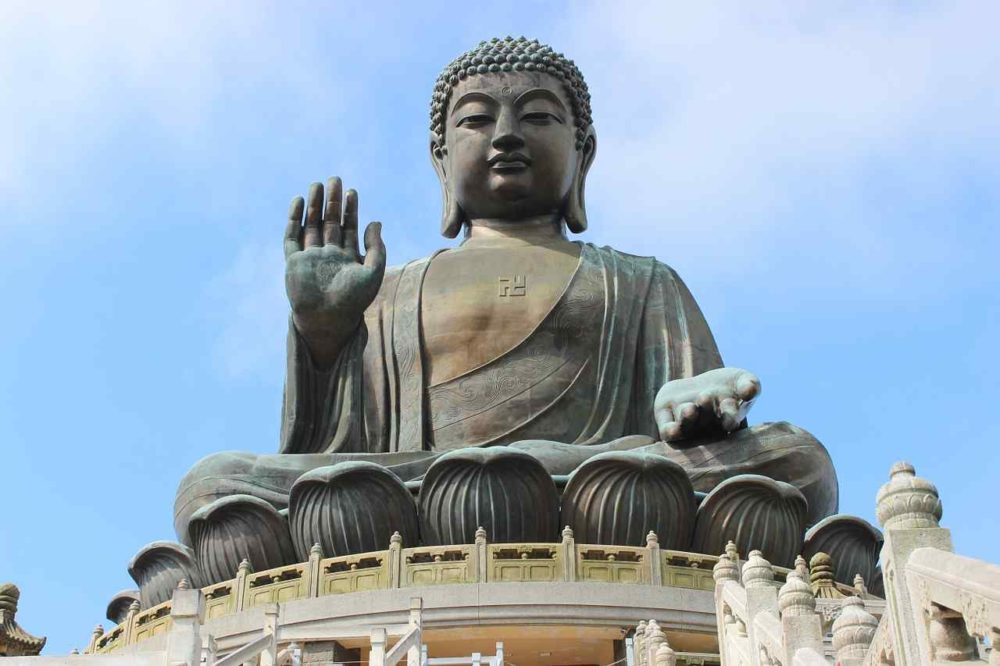
Buddhist scriptures give
significance to simplicity, leaving behind all the negativity and ill
thoughts. Buddhism follows the teachings of Gautama Buddha, who took
birth as Siddhartha Gautama in Lumbini in 567BCE. Born into a royal
family, he had all the luxuries of life but the experiences made him
realise spirituality and the essence of true happiness that lies away
from materialistic objects. The Prince then gave away all his wealth and
went out to seek what he truly wanted.
Buddhism is about Buddha’s ideologies; karma, compassion and wisdom,
and enlightenment. Buddhist temples have a peaceful environment with
prayer bells, Buddhist paintings depicting tales, Buddhist literature
and holy chants. Unlike other religion, Buddhism does not necessarily
believe is worshipping the statue. Rather, the Buddhists sit barefoot in
front of the statue and offer prayer. Here is a list of Buddha Statues
that you must see once in your life.
SIDDHARTHA GAUTAMA was a sovereign in India around 500 BC who set out
to find significance in the enduring he saw. When he discovered
enlightenment, he started to spread his way of thinking. He ended up
known as Buddha, a title, since given to other people, that signifies
“stirred one”. Here is the list of 16 Famous Buddha Statues:
Famous Buddha Statues In The World
1. SPRING TEMPLE BUDDHA, HENAN, CHINA
Spring Temple Buddha in Henan, China definitely tops the list. And it
will truly amaze your sight. Standing tall at a height of 420 feet,
above a lotus-shaped pedestal of 66 feet, this statue has been placed in
the Guinness Book of World records for being the largest statue in the
world. The enormous Buddha statue is built with 108kg of gold, 3,300
tonnes of copper alloy and 15,000 tonnes of steel. The diamond seat
below the pedestal contains 6,666 small Buddha statues. Visitors can
climb up and touch the toes of the Spring Temple Buddha.
Also Read: 10 Most Famous Jesus Statues In The World
2. MONYWA BUDDHA, MONYWA, MYANMAR
Monywa Township is a place of spiritual interaction. Monywa Buddha is
the second tallest statue. Wrapped in a golden rope, the towering tall
standing Buddha statue can be seen from far away. Built-in 2008, the
statue is 423 feet tall. It comprises 31 stories that represent 31
planes of existence. The beauty and divinity of the statue can’t be
described in mere words. Below it lays the reclining statue that is 312
feet long. That’s not all; the garden is filled with numerous Buddha
statues sitting in the same position.
Monywa is a city in focal Myanmar situated on the banks of the
Chindwin River. Only east of the city is the Po Khaung Taung, a scope of
slopes where you can see the Monywa Buddha–the biggest leaning back
Buddha statue on the planet. This huge figure estimates 90 meters (300
feet) long. The head alone is 60 feet high. The Monywa Buddha was built
in 1991 and is empty inside, enabling guests to stroll along from the
head to the feet. Inside the figure are 9,000 one-foot-high metal
pictures of the Buddha and his supporters, delineating different
portrayals of significant occasions in the Buddha’s life. As of late an
immense standing Buddha statue was based over Po Kaung Hills. At 132
meters (433 feet) high it is one of the biggest Buddha statues on the
planet.
3. LESHAN GIANT BUDDHA, CHINA
Leshan Giant Buddha is 232.94 feet tall and has been honored as the
largest Maitreya Buddha statue in ten worlds. It is also a World
Heritage site declared by UNESCO. The giant Buddha was carved from the
mountain and faces the Leshan City. The river below its feet appears as a
part holy ritual to wash Buddha’s feet. Completed in 803 AD, the statue
in China is well maintained due to the dynamic design and structure.
The Giant Buddha of Leshan is a huge Buddha statue cut out of a
precipice face in Sichuan, western China. The incredible model is a
figure of Maitreya — a Bodhisattva customarily spoke to in sitting
stance. Started in the year 713 during the Tang Dynasty, the statue was
not finished until the year 803 and was the exertion of thousands of
stone carvers and laborers. As the greatest cut stone Buddha on the
planet, the Leshan Giant Buddha is highlighted in verse, tune and story.
The model has a height of 71 meters from top to bottom and has 3 meter
long fingers on all of its enormous resting hands. Today it is a famous
vacation spot in China.
4. DAIBUTSU AT TODAI-JI, NARA, JAPAN
Todai-Ji holds an integral part in the history of Japanese culture
and history. And Daibutsu in its complexity is the World’s largest
bronze statue. The statue 49.29 feet tall sits in a position that
represents Vairocana. There are many other attractions, like a pillar
that has a hole in its base which is as big as the nostril of Daibutsu.
Sika deer that are considered to be the messengers of God move here
freely. You can also visit the Todaiji Museum, Hokkedo Hall, Kaidanin
Temple, and etcetera.
5. WAT PHO, BANGKOK
Wat Pho, the oldest temple in Bangkok has the magnificent statue of
the reclining Buddha. Build during the rule of King Rama III, the statue
represents Gautama Buddha lying down before entering parinirvana. The
gold plated Reclining statue is 46 meters long and 15 meters high. The
feet are 5 meters long and delicately decorated. That’s not all, the
temple complex and hundreds of Buddha statues.
6. TEMPLE OF EMERALD BUDDHA, THAILAND
The most sacred Buddha temple in Thailand, Wat Phra Kaew or The
temple of Emerald Buddha is truly mesmerising. Situated in Phra Nakhon
district, the temple is within the premises of Grand Palace. The Emerald
Buddha statue is in the colour dark green and measures 66 centimetres
tall. Sitting in a meditation position, the Buddha statue is made from a
single dark green jade. Every season, the attire of Buddha is changed
by the Prince.
Another of Bangkok’s Buddhist sanctuaries is Wat Phra Kaew, the
Temple of the Emerald Buddha, situated inside the grounds of the Grand
Palace. The principle building is the focal ubosoth, which houses The
Emerald Buddha, one of the most established and most well known Buddha
statues on the planet.
A jade statue embellished in gold dress, the Emerald Buddha was, as
indicated by legend, made in India in 43 BC in the city of Pataliputra,
where it stayed for a long time. In the fourth century AD it was removed
to Sri Lanka by Buddhist priests to spare it from obliteration by war.
Inevitably the statue advanced toward Thailand and was moved to Wat Phra
Kaew in 1779. The statue has three unique arrangements of gold apparel,
which are changed by the King of Thailand in a service at the changing
of the seasons.
Related: Top 10 Most Visited Cities In The World 2018
7. GREAT BUDDHA OF KAMAKURA, JAPAN
Dating back to 1252, The Great Buddha of Kamakura was once inside a
temple until a Tsunami destroyed it and then the statue was housed in
the open air. Back then, it was entirely gold plated, but as centuries
have passed by, the shine has also faded, except graces of gold near its
ears. There were also 32 bronze lotus petals at the base, 4 out of
which remain today. The huge bronze statue (now) representing the Amida
Buddha weighs 93 tons and is 13.35 metres tall. Well, visitors can even
enter inside the Buddha statue.
The Kotoku-in is a Buddhist sanctuary of the Jodo shu order situated
in the city of Kamakura in Japan. The sanctuary is celebrated for its
extraordinary Buddhist statue. A titanic outside portrayal of Amida
Buddha, a standout amongst Japan’s most observed Buddhist figures. Cast
in bronze, the Great Buddha remains at more than 13 meters (40 feet)
high and weighs about 93 tons.
The statue allegedly dates from 1252 and is, for the most part,
accepted to have been thrown by the Buddhist priest Joko, who likewise
gathered gifts to assemble it. In spite of the fact that it initially
was housed in a little wooden sanctuary, the Great Buddha presently
remains in the outside as the first sanctuary was washed away in a
torrent in the fifteenth century.
8. AYUTTHAYA BUDDHA HEAD, THAILAND
Wat Mahathat in Ayutthaya is a famous Buddhist site in Thailand. But
what makes it more interesting is its rich history. Once a temple,
Ayutthaya was attacked by the Burmese Army in 1767 and it came down to
nothing but ruins. It was in the 1950s when the restoration work began.
Even if the temple was entirely damaged, the stone Buddha head was
there, tangled by a huge tree. The theory still lies undiscovered but
the site is a major tourist attraction.
Thailand’s city of Ayutthaya is the area of one of the world’s most
strange Buddhist statues. Among the vestiges of Wat Mahathat (The Temple
of the Great Relic) is the remaining parts of a sandstone statue of the
Buddha whose body has been lost to the ages yet whose headrests
properly in the climbing roots and vines of a tree. Around this
acclaimed figure is numerous other stature of the Ayutthaya time frame
which has endured the assaults of time.
9. GAL VIHARA, SRI LANKA
The UNESCO World Heritage site at Polonnaruwa presents you the sight
of Gal Vihara’s four cave shrines. Apparently, all of the Buddha statues
were cut from a single slab of granite. Cave of Vijjadharas, The
Excavated Cave, The cave of Standing Image and The cave of reclining
image. The 7m tall statue of Buddha that is in the “Cave of Standing
Image” and the 14 m long reclining Buddha are the most magnificent out
of all.
10. USHIKU DAIBUTSU, USHIKU, JAPAN
Situated in the city of Tsukuba, Ushiku Daibutsu is a major
attraction. The former tallest Buddhist statue in the world, Ushiku
Daibutsu is 120m tall. And if you think that’s all then you must
reconsider. The bronze statue weighs 4000 tons. The Ushiku Daibutsu tour
includes visitors going into the various exhibition halls on the first
and second floors. The most fascinating one being the ‘World of the
Lotus Sanctuary’ that has over 3000 gold Buddha statues.
The Ushiku Daibutsu is situated in the city of Ushiku in Japan.
Completed in 1995, the figure is one of the world’s tallest statues,
standing a sum of 120 meters (394 feet) high including the 10m (30 foot)
base and 10m high lotus stage. Guests to the Buddha statue can take a
lift to a stage where a perception deck is arranged. The bronze-plated
figure outlines Amitabha Buddha and is generally called Ushiku Arcadia.
11. Hussain Sagar Buddha Statue, Hyderabad, India
Hussain Sagar Buddha Statue is a monolith situated in India. Also, it
is the world’s tallest monolith of Gautama Buddha, erected on Gibraltar
Rock in the middle of Hussain Sagar. The statue stands on a concrete
platform measuring 15 feet tall and this platform known as the “Rock of
Gibraltar” and was constructed in the middle of Hussain Sagar. The
statue was sanctioned by the Sri Late N. T. Rama Rao between 1983 and
1989 who was serving as the chief minister of Andhra Pradesh, Now it is
part of Telangana which was separated from Andhra Pradesh on 2 June
2014.
The Buddha statue arranged at the focal point of a fake lake in the
city of Hyderabad is a standout amongst India’s most well known Buddha
statues. This figure remains at an entire 17 meters (56 feet) tall and
weighs 320 tons. The single biggest solid statue in all of India, it was
etched by a gathering of craftsmen from a solitary bit of stone.
Deplorably, during the statue’s establishment in 1992, the figure
spilled and fell into the lake, causing the passing of 8 specialists.
The administration recuperated the statue and reestablished it to its
full tallness and stature.
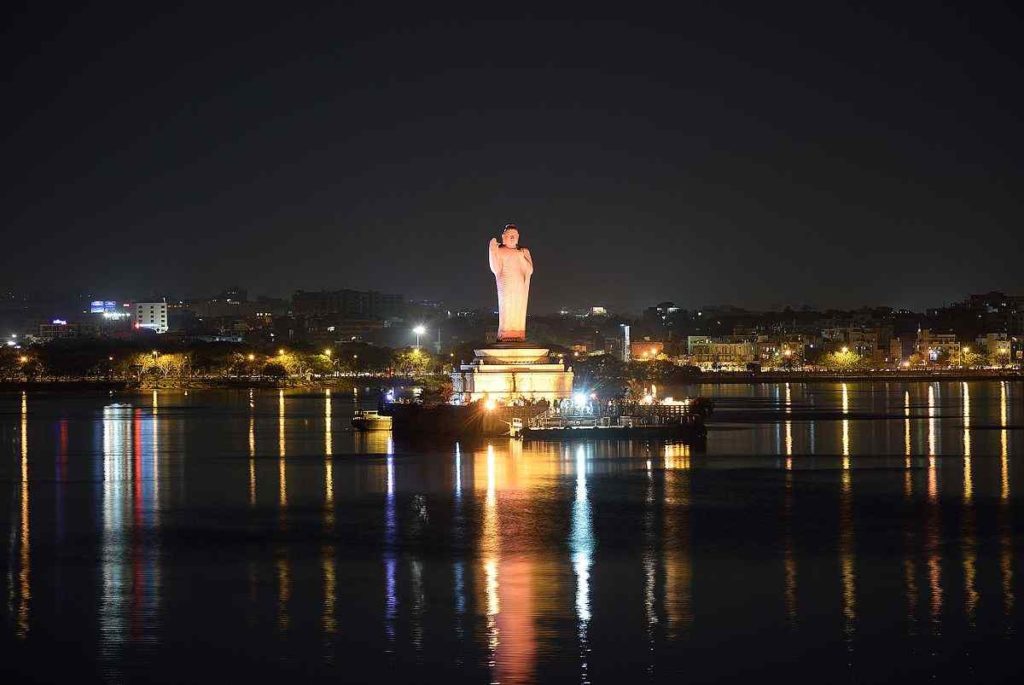
12. Tian Tan Buddha Statue, Hong Kong, China
One of the famous Buddha statues, Tian Tan Buddha Statue situated on
the Ngong Ping, Lantau Island and the construction was completed in
1993. The giant and bronze statue is termed as the epicentre of Buddhism
in Hong Kong and gives the message of faith and people, man and nature.
The base of the statue was constructed in the model of the Temple of
Heaven in Beijing. It is also listed as one of China’s five large Buddha
statues and made up of three platforms and resembles a lotus.
Tian Tan Buddha now and again privately alluded to as the Big Buddha,
is situated on Lantau Island, in Hong Kong. Formed of bronze and
finished in 1993, The statue is the primary element of the Po Lin
Monastery, symbolizing amicability between man, nature, individuals, and
religion. The statue sits on a lotus position of royalty over a
three-layered special stepped area. At 34 meters (110 feet) tall, the
Tian Tan Buddha is exhibited in a stance of peacefulness. His correct
hand is raised to expel pain. His left-hand lay on his knee, speaking to
joy.
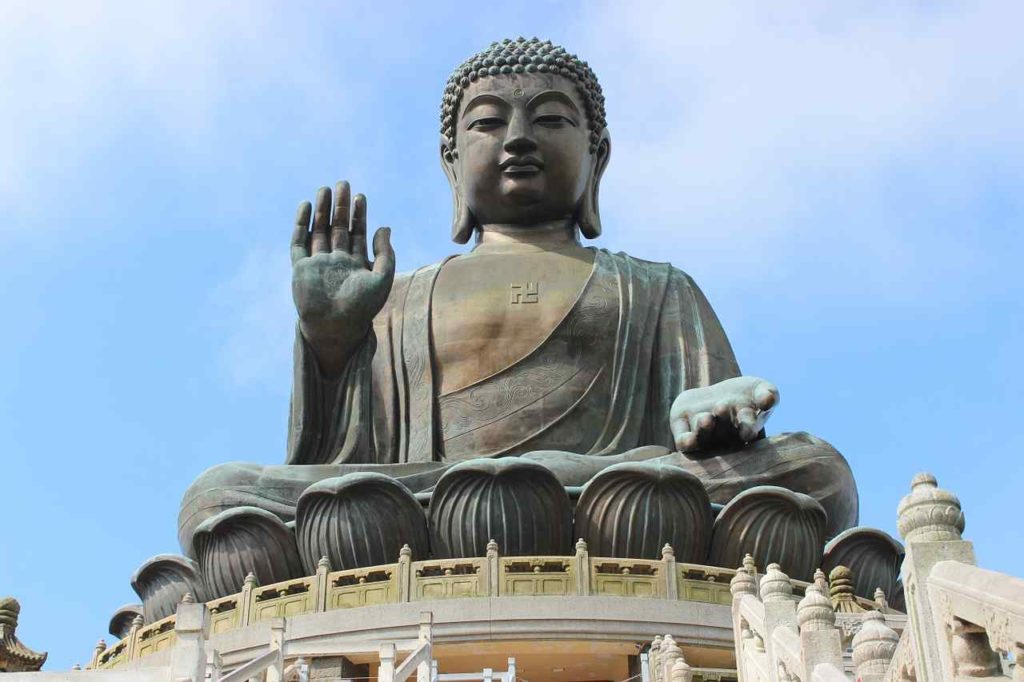
13. Temple of the Reclining Buddha, Bangkok, Thailand
Also known as the Wat Pho situated in the district of Phra Nakhon in
Bangkok. It is popularly known as the Grand Palace of Thailand and it is
an amazing prediction of thai traditional culture and massage. The
temple is one of the oldest and biggest temples in the Bangkok area
located around eighty thousand square meters and in this area there are
approximately a thousand images of Buddha as well as the ever famous
Phra Buddhasaiyas or the reclining Buddha. The statue is forty-six
meters wide and fifteen meters tall with gold plating as its decorations
and eyes made of mother of pearl.
Situated in Bangkok, Wat Pho is renowned for the enormous Reclining
Buddha statue it houses. It is one of the biggest sanctuaries in Bangkok
and furthermore one of the most seasoned, developed about 200 years
before Bangkok turned into Thailand’s capital. Wat Pho holds the
qualification of having both Thailand’s biggest leaning back Buddha
picture and the biggest number of Buddha pictures in Thailand. The
gold-plated Reclining Buddha statue is 46 meters in length and 15 meters
high and remembers the death of the Buddha into Nirvana. The statue’s
eyes and feet are enlivened with engraved mother of pearl, the bottoms
of the feet showing the 108 favorable qualities of the genuine Buddha.
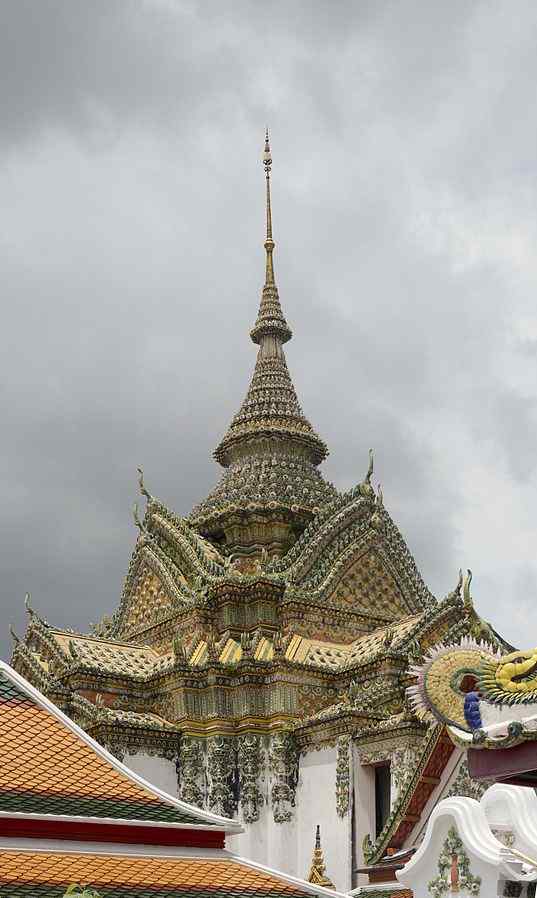
14. Buddha Dordenma, Thimphu, Bhutan
The statue is situated at the top of the hill in Thimphu which is the
capital and largest city of Bhutan. The gigantic Budha statue in the
mountains of Bhutan celebrating the 60th anniversary of fourth king
Jigme Singye Wangchuck. The height of the statue is 51.5 m and that it
one of the largest statues of Budha in the world. The statues were
completely made of Bronze and are gilded in gold. There are 125,000
smaller Buddha statues that have been placed within the Buddha Dordenma
statue and 100,000 statues of which are 8-inches-tall and 25,000 statues
of which are 12 inches tall.
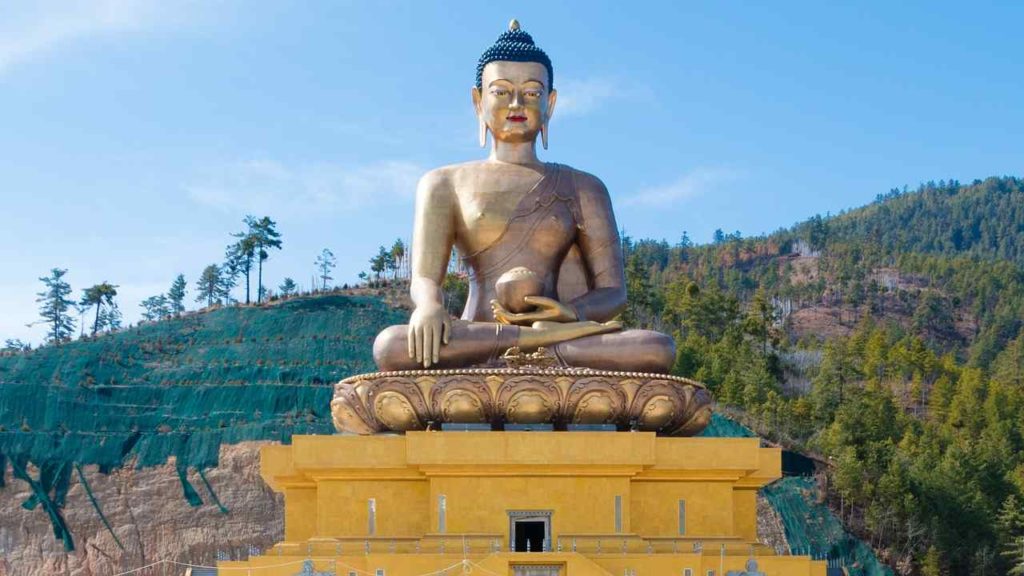
15. Grand Buddha at Ling Shan, Wuxi, China
The Grand Budha statue situated in the south of the Longshan
Mountain, near Mashan, the town of Wuxi, Jiangsu Province, People’s
Republic of China and listed as one of the largest statues of Budha in
China and across the globe. The statue located at the Ling Shan is a
bronze Amitabha standing Buddha outdoor and was completed at the end of
1996. The height of the statue is 88 meters that include 9 m lotus
pedestal.
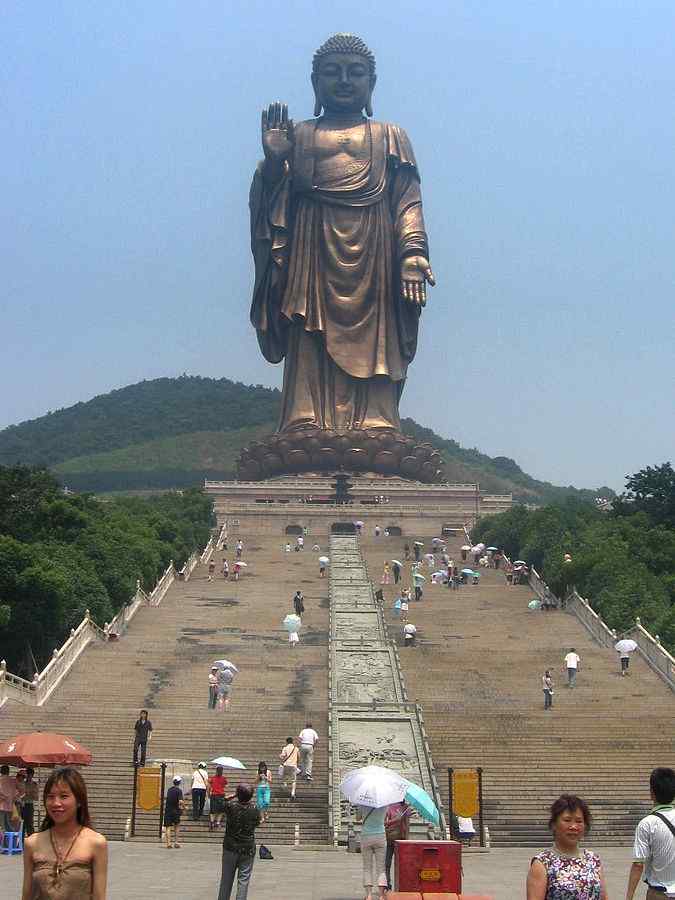
16. Gal Vihara, Nissankamallapura, Sri Lanka
Situated in north focal Sri Lanka, Polonnaruwa is the site of a
standout amongst the most amazing of the world’s portrayals of the
Buddha – the Gal Viharaya. This huge shake sanctuary was built by
Parakramabahu the Great in the twelfth century. The focal fascination of
the sanctuary are 4 enormous Buddha statues cut into the essence of
rock stone. Among these mammoth stone, figures are a leaning back statue
of the Buddha that estimates 14 meters (46 feet) long and a standing
figure estimating 7 meters (23 feet) high.

These are the 18 Most Famous Buddha Statues in the world. They are
not only great tourist attractions but also a hub of spirituality and
intellectuality.
1. BEING COMPASSION introduction
Rik Jespersen
BEING COMPASSION is a step-by step video guide to a transformative Tibetan-style meditation using the figure of Chenrezi (also known as Avalokiteshavara) to help develop a powerful compassionate presence.
![]()
|
base=”http://admin.brightcove.com/viewer/” quality=”high” bgcolor=”#FFFFFF” Join our National Movement for ChangeSenator Clinton made history Plan to Strengthen Civil Rights
At a Glance |
http://www.samye.org/refuge.htm
![[Main ROKPA Homepage]](http://www.samye.org/images/anilonew.gif)


Rector
JC



http://www.halfvalue.com/searchResultsVideos.jsp?kw=Buddhism
http://www.halfvalue.com/playVideo.jsp?kw=Buddhism&id=aoCgZ9yBIoU
Buddhism Videos
http://www.halfvalue.com/playVideo.jsp?kw=Buddhism&id=ijshNb7Mt0M
Buddhism Videos
Buddhism
http://www.halfvalue.com/playVideo.jsp?kw=Buddhism&id=oJa4r9NoXmQ
http://www.halfvalue.com/playVideo.jsp?kw=Buddhism&id=jpJo-kg7Qdk
Buddhism Videos
http://www.halfvalue.com/playVideo.jsp?kw=Buddhism&id=EfejjvVC4TY
Buddhism Videos
http://www.halfvalue.com/playVideo.jsp?kw=Buddhism&id=vid-DSBiY38
Buddhism Videos
http://www.halfvalue.com/playVideo.jsp?kw=Buddhism&id=vgZ3zKNYURU
Buddhism Videos
Rector
JC


http://www.halfvalue.com/searchResultsVideos.jsp?kw=Buddhism
http://www.halfvalue.com/playVideo.jsp?kw=Buddhism&id=aoCgZ9yBIoU
Buddhism Videos
http://www.halfvalue.com/playVideo.jsp?kw=Buddhism&id=ijshNb7Mt0M
Buddhism Videos
Buddhism
http://www.halfvalue.com/playVideo.jsp?kw=Buddhism&id=oJa4r9NoXmQ
http://www.halfvalue.com/playVideo.jsp?kw=Buddhism&id=jpJo-kg7Qdk
Buddhism Videos
http://www.halfvalue.com/playVideo.jsp?kw=Buddhism&id=EfejjvVC4TY
Buddhism Videos
http://www.halfvalue.com/playVideo.jsp?kw=Buddhism&id=vid-DSBiY38
Buddhism Videos
http://www.halfvalue.com/playVideo.jsp?kw=Buddhism&id=vgZ3zKNYURU


